Wednesday, January 15. 2014
Does humanity’s tightening grip on the fate of nature portend new sources of global conflict? | #climate #geoengineering
-----
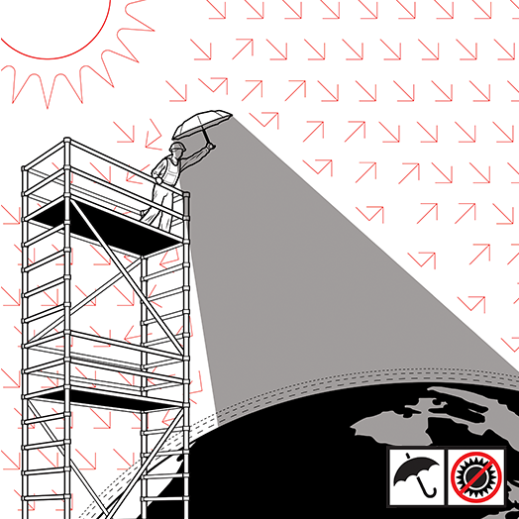
Illustration by McKibillo
More than a decade ago, Paul Crutzen, who won the 1995 Nobel Prize in chemistry for his research on the destruction of stratospheric ozone, popularized the term “Anthropocene” for Earth’s current geologic state. One of the more radical extensions of his idea—that human activity now dominates the planet’s forests, oceans, freshwater networks, and ecosystems—is the controversial concept of geoengineering, deliberately tinkering with the climate to counteract global warming. The logic is straightforward: if humans control the fate of natural systems, shouldn’t we use our technology to help save them from the risks of climate change, given that there’s little hope of cutting emissions enough to stop the warming trend?
In recent years a number of scientists—including Crutzen himself in 2006—have called for preliminary research into geoengineering techniques such as using sulfur particles to reflect some of the sun’s light back into space. With the publication of A Case for Climate Engineering, David Keith, a Harvard physicist and energy policy expert, goes one step further. He lays out arguments—albeit hedged with caveats—for actually deploying geoengineering. He says that releasing sun-blocking aerosol particles in the stratosphere (see “A Cheap and Easy Plan to Stop Global Warming,” March/April 2013) “is doable in the narrow technocratic sense.”
Indeed, Keith is steadfastly confident about the technical details. He says a program to cool the planet with sulfate aerosols—solar geoengineering—could probably begin by 2020, using a small fleet of planes flying regular aerosol-spraying missions at high altitudes. Since sunlight drives precipitation, could reducing it lead to droughts? Not if geoengineering was used sparingly, he concludes.
Australian ethicist Clive Hamilton calls the book “chilling” in its technocratic confidence. But Keith and Hamilton do agree on one thing: solar geoengineering could be a major geopolitical issue in the 21st century, akin to nuclear weapons during the 20th—and the politics could, if anything, be even trickier and less predictable. The reason is that compared with acquiring nuclear weapons, the technology is relatively easy to deploy. “Almost any nation could afford to alter the Earth’s climate,” Keith writes. That fact, he says, “may accelerate the shifting balance of global power, raising security concerns that could, in the worst case, lead to war.”
Thing reviewed
A Case for Climate Engineering
David Keith MIT Press, 2013
The potential sources of conflict are myriad. Who will control Earth’s thermostat? What if one country blames geoengineering for famine-inducing droughts or devastating hurricanes? No treaties ban climate engineering explicitly. And it’s not clear how such a treaty would operate.
Keith professes ambivalence about whether humans are truly able to wield such powerful technology wisely. Yet he feels that the more information scientists uncover about the risks of geoengineering, the lower the chances the technology will be used recklessly. Though his book leaves unanswered many of the questions that arise over how to govern geoengineering, a policy paper that he published in Science last year goes further to address them: he and a coauthor proposed government authority over research and a moratorium on large-scale geoengineering but said there should be no treaties regulating small-scale experiments.
Hamilton says this approach would lead nations on a path toward the conflict that he thinks would inevitably surround geoengineering. Allowing lightly regulated small experiments, he suggests, could undermine the urgency of political efforts toward cutting emissions. This, in turn, increases the possibility that geoengineering will be used, since failing to restrain emissions will leave temperatures rising. Hamilton accuses Keith of seeking a “naïve … cocoon of scientific neutrality” and says researchers cannot “absolve themselves of responsibility for how their schemes might be used or misused in the future.”
That may be true, but Keith deserves credit for directing attention to ideas he knows are dangerous. Accepting the concept of the Anthropocene means accepting that humans have the responsibility to find technological fixes for disasters they have created. But little progress has been made toward a process for rationally supervising such activity on a global scale. We need a more open discussion about a seemingly outlandish but real geopolitical risk: war over climate engineering.
Personal comment:
"Who will control Earth’s thermostat?" Oh well, following yesterday's news, I would suggest Google, they have "smart" technology ...
By the way, will we also reach some "climate neutrality quash" one day (compared to "net neutrality quashed" by a federal court), once global weather will definitely be an artifact and a product?
Wednesday, September 18. 2013
Lightning Farm
Via BLDGBLOG
-----
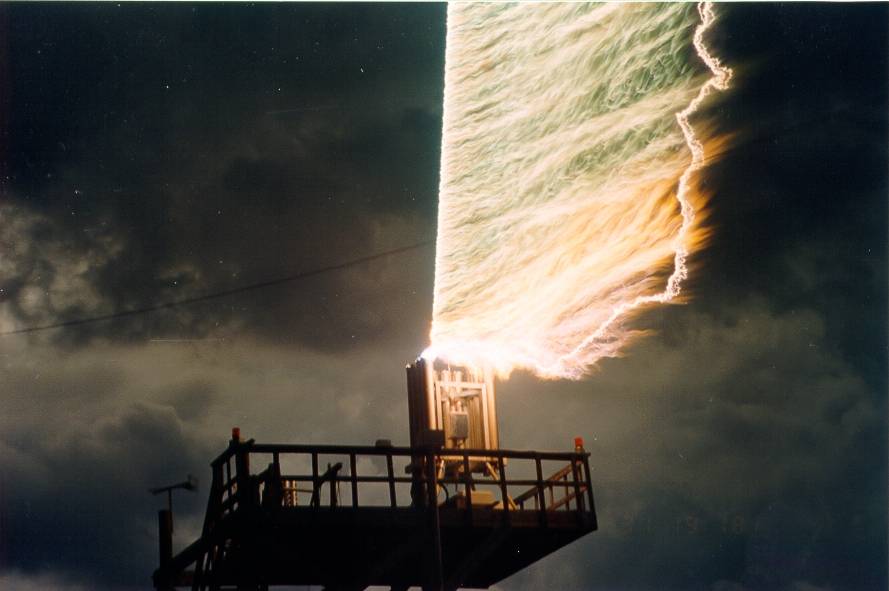
[Image: Triggered lightning technology at the University of Florida's Lightning Research Group].
This past winter, I had the pleasure of traveling around south Florida with Smout Allen, Kyle Buchanan, and nearly two dozen students from Unit 11 at the Bartlett School of Architecture.
Florida's variable terrains—of sink holes, swamps, and eroding beaches—and its Herculean infrastructure, from canals and freeways to theme parks and rocket facilities, served as the narrative backdrop for the many architectural projects ultimately produced by the class (in addition, of course, to the 2012 U.S. Presidential election, the results of which we watched live from the bar of a tropical-themed hotel near Cape Canaveral, next door to Ron Jon).
While there were many, many interesting projects resulting from the trip, and from the Unit in general, there is one that I thought I'd post here, by student Farah Aliza Badaruddin, particularly for the quality of its drawings.
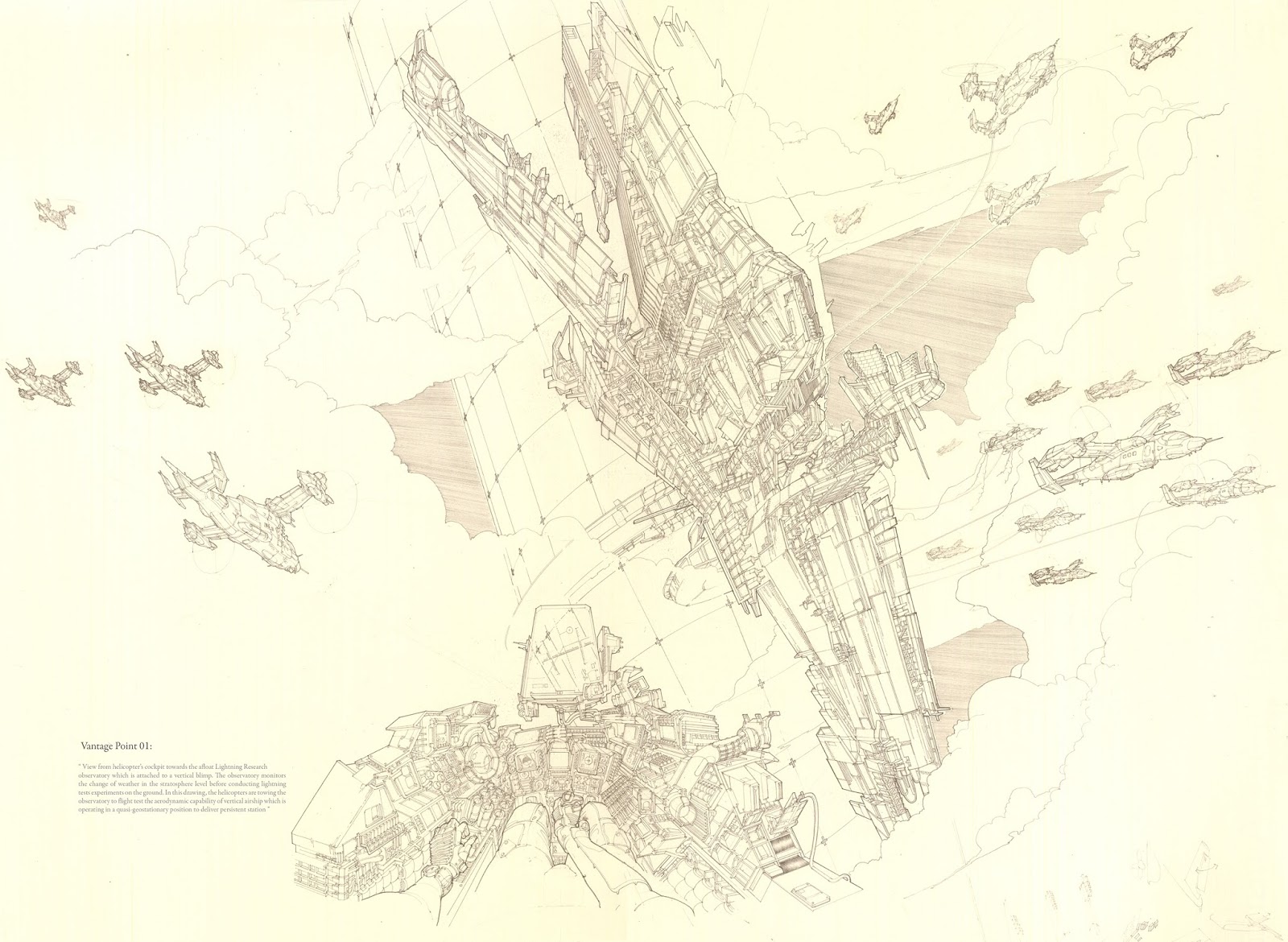
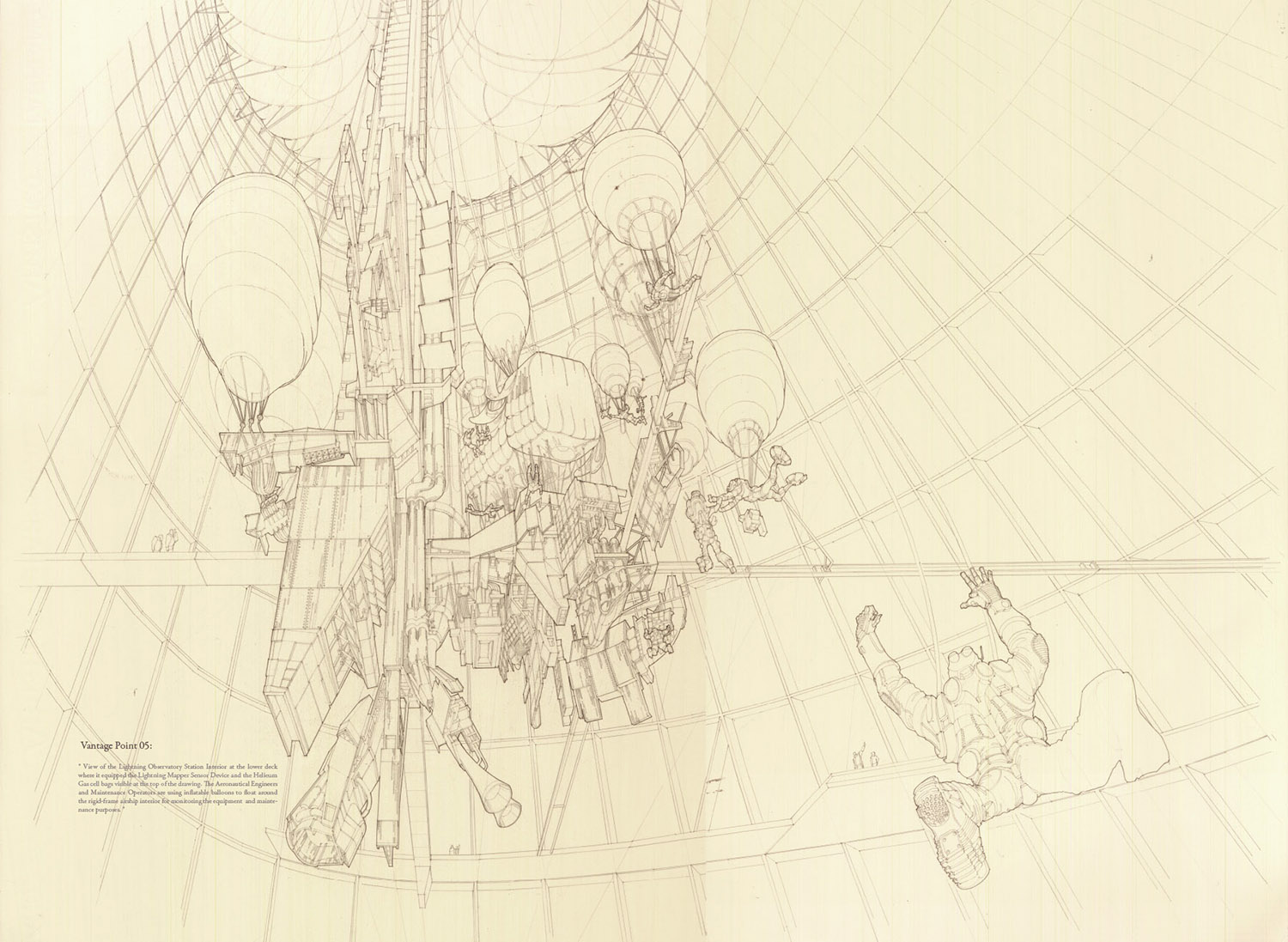
[Images: From a project by Farah Aliza Badaruddin at the Bartlett School of Architecture].
Badaruddin's project explored the large-scale architectural implications of applying radical weather technologies to the task of landscape remediation, asking specifically if Cape Canaveral's highly contaminated ground water—polluted by a "viscous toxic goo" made from tens of thousands of pounds of rocket fuels, chemical plumes, solvents, and other industrial waste products over the decades—could be decontaminated through pyrolysis, using guided and controlled bursts of lightning.
In her own words, Badaruddin explains that the would test "the idea that lightning can be harnessed on-site to pyrolyse highly contaminated groundwater as an approach to remediate the polluted site."
These controlled and repetitive lightning strikes would also, in turn, help fertilize the soil, producing a kind of bio-electro-agricultural event of truly cosmic (or at least Miller-Ureyan) proportions.
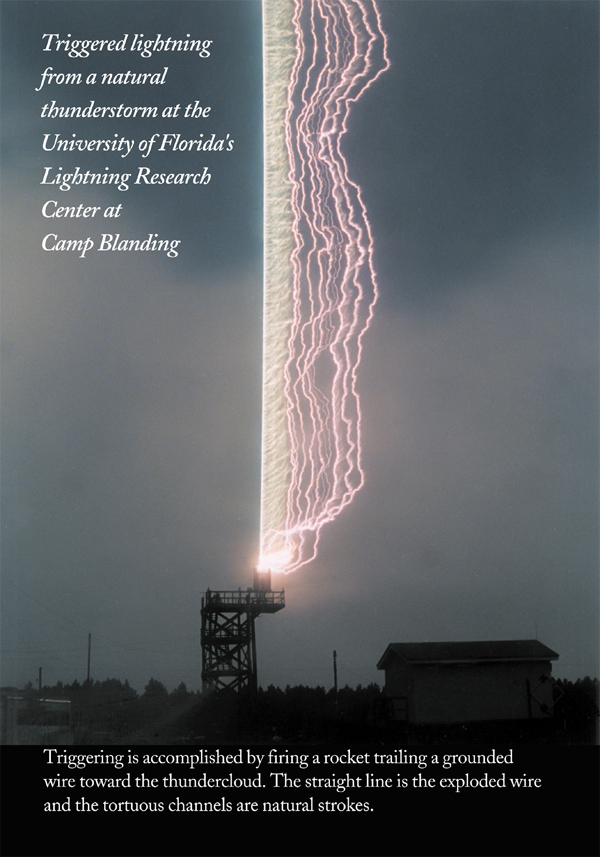
[Image: Triggered lightning technology at the University of Florida Lightning Research Group].
Her maps of the area—which she presents as if drawn in a Moleskine notebook—show the terrestrial borders of the proposal (although volumetric maps of the sky, showing the project's fully three-dimensional engagement with regional weather systems, would have been an equally, if not more, effective way of showing the project's spatial boundaries).
This raises the awesome question of how you should most accurately represent an architectural project whose central goal is to wield electrical influence on the atmosphere around it.
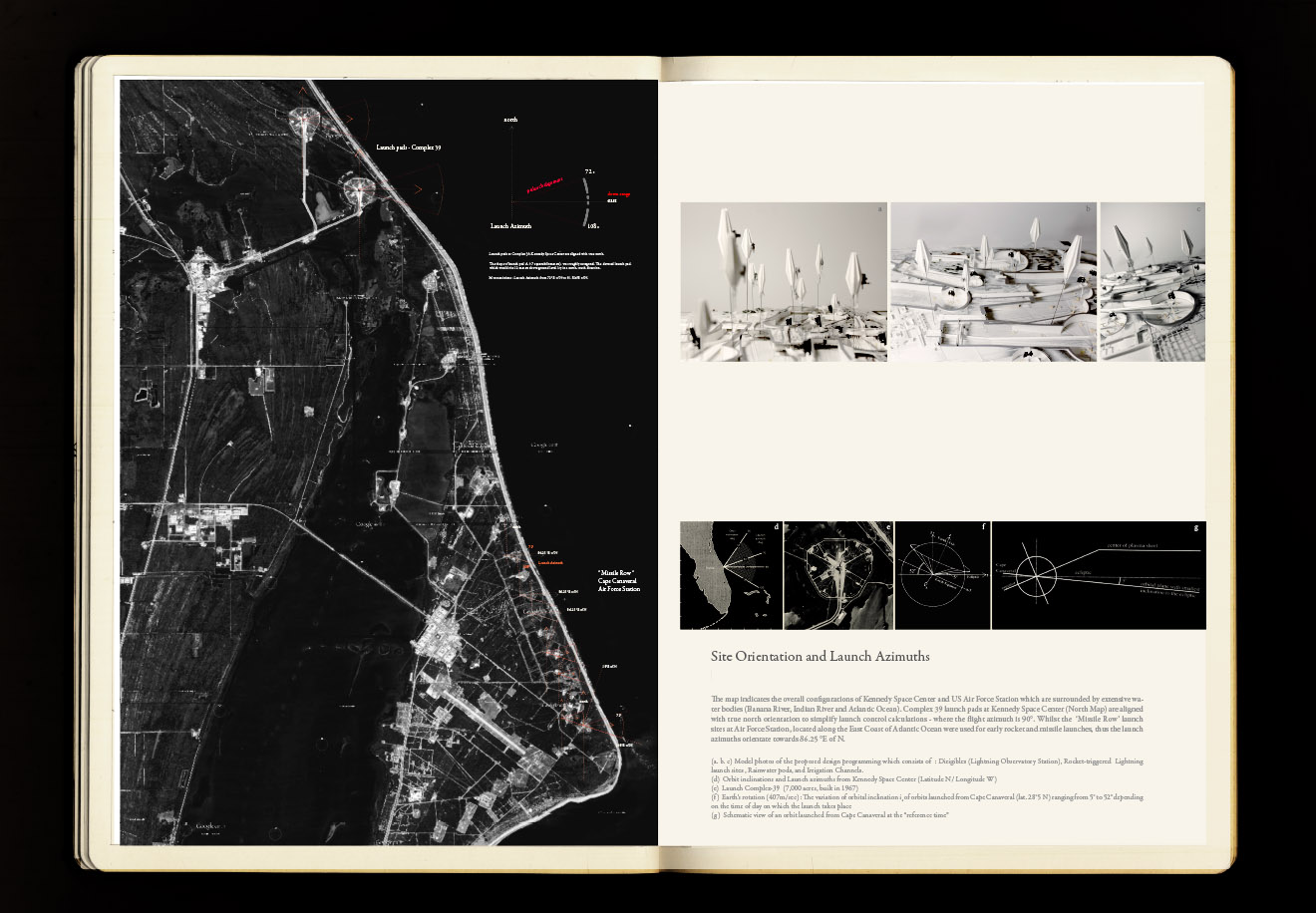
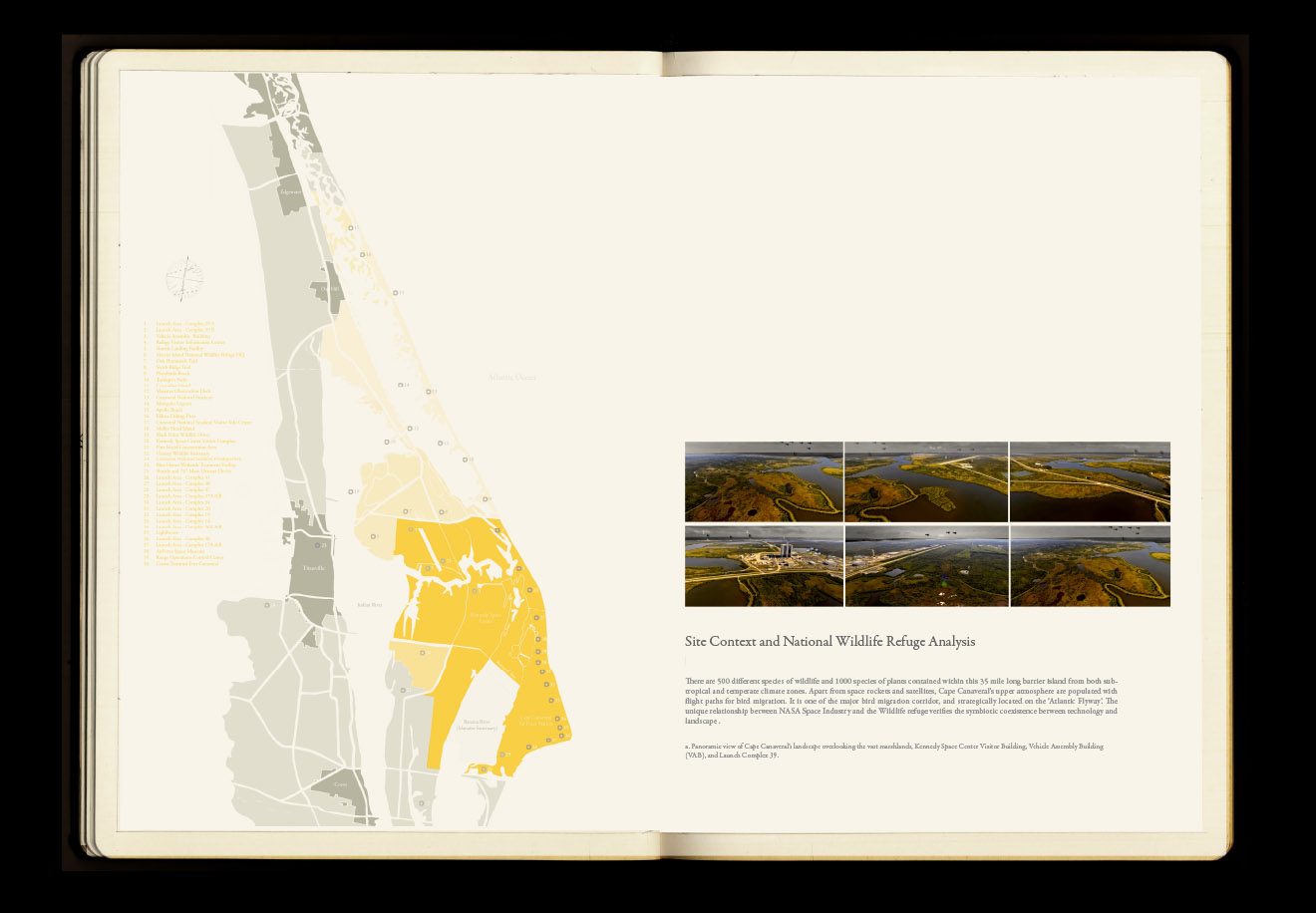
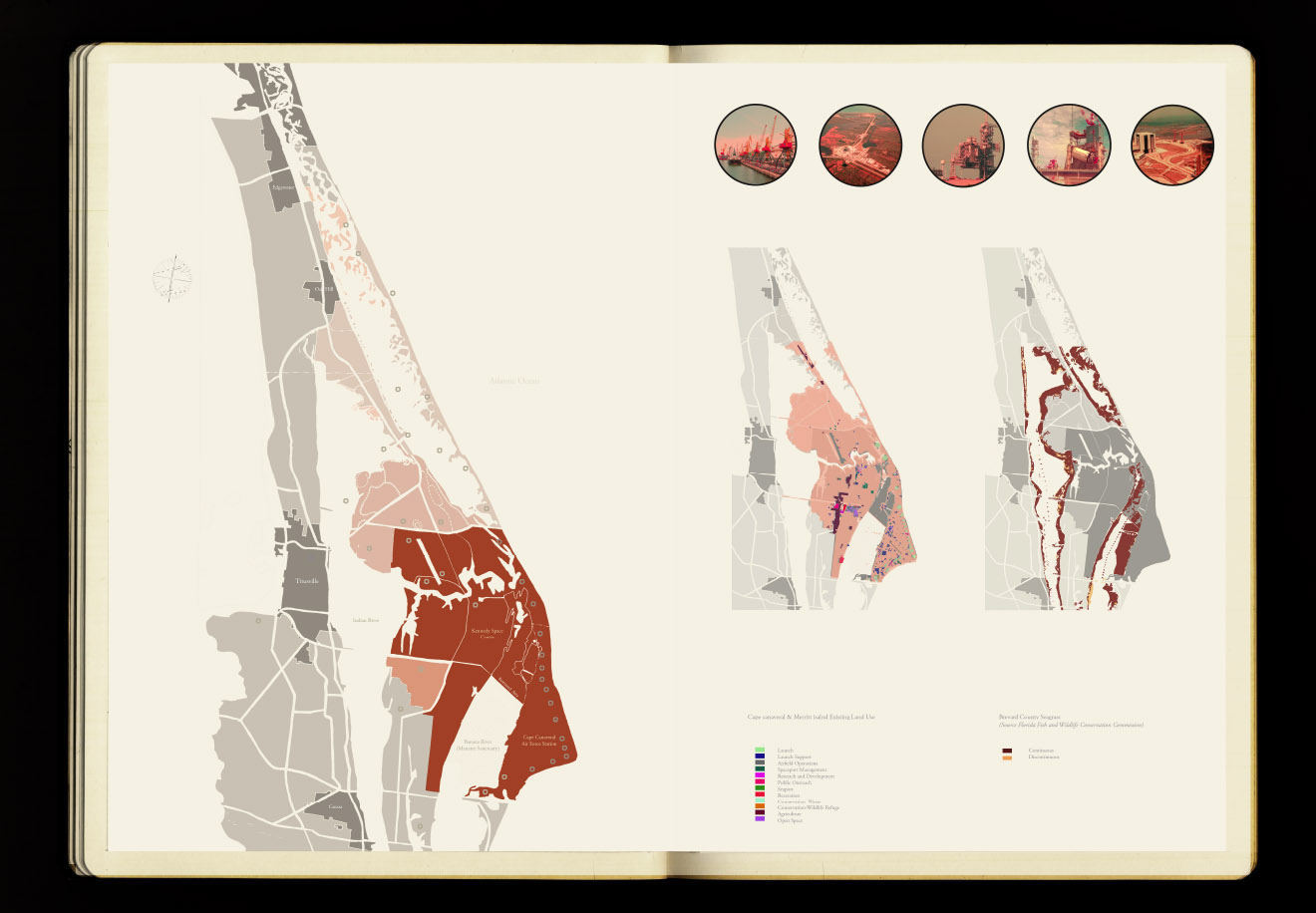
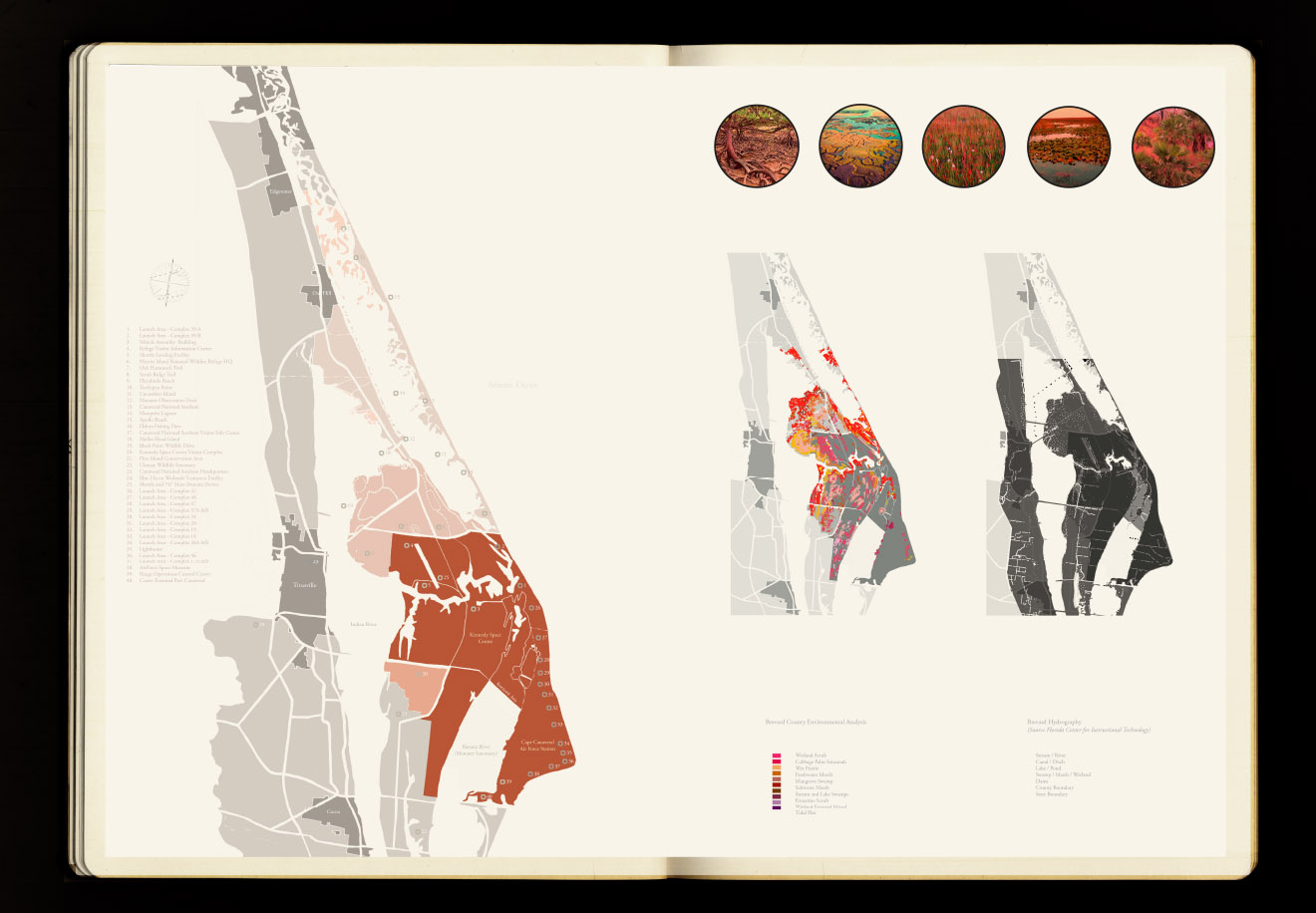
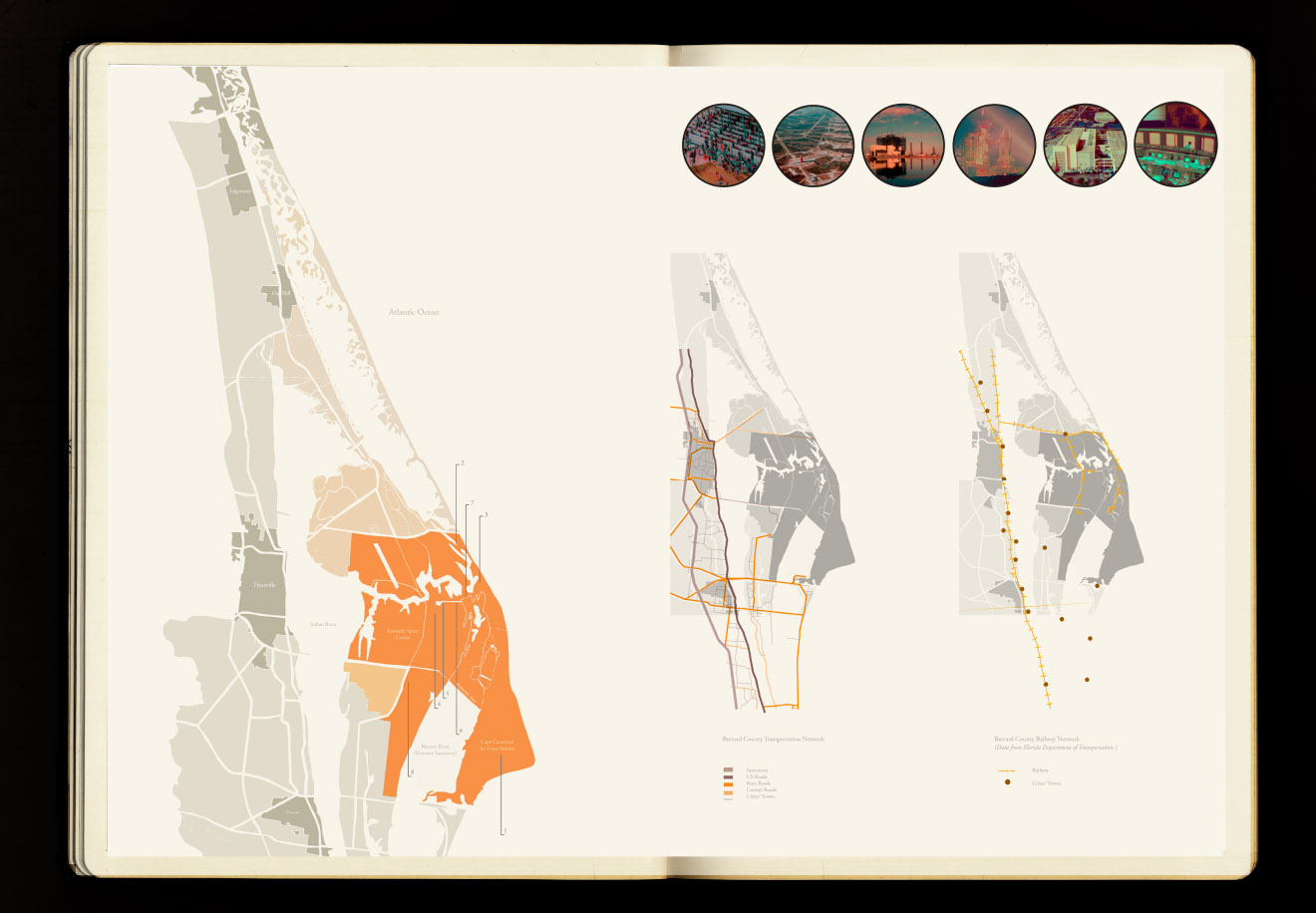
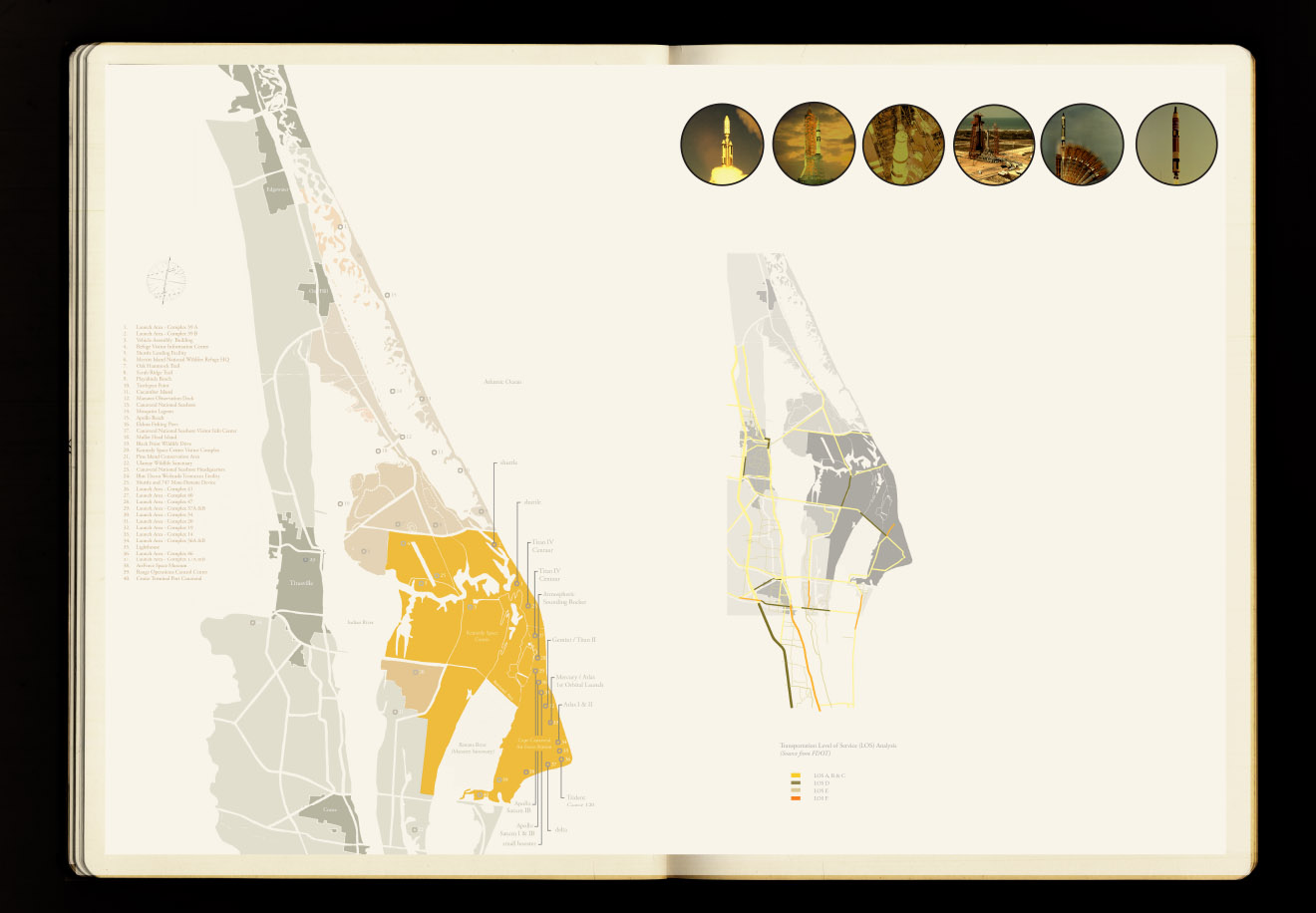
[Images: From a project by Farah Aliza Badaruddin at the Bartlett School of Architecture].
In short, her design proposes a new infrastructure of "rocket-triggered lightning technology," assisted and supervised by a peripheral network of dirigibles—floating airships that "surround the site and serve as the observatory platform for a proposed lightning visitor centre and the weather research center."
The former was directly inspired by real-world lightning research equipment found at the University of Florida's Lightning Research Group.
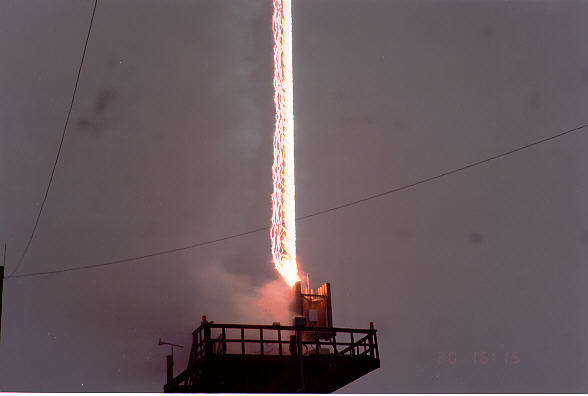
[Image: Triggered lightning technology at the University of Florida's Lightning Research Group].
Badaruddin's own rocket triggers would be used both to attract and "to provide direct lightning strikes to the proposed sites," thus pyrolizing the landscape and purifying both ground water and soil.
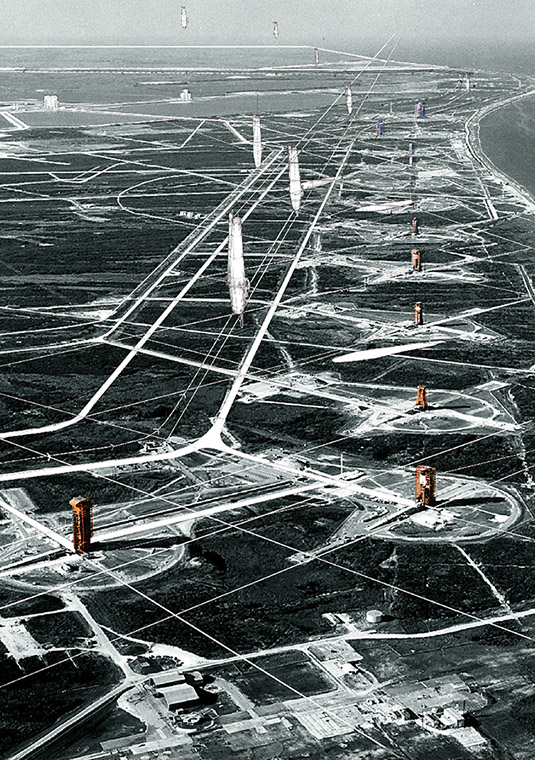
[Image: Aerial collage view of the lightning farm, by Farah Aliza Badaruddin at the Bartlett School of Architecture].
The result would be a lightning farm, a titanic landscape tuned to the sky, flashing with controlled lightning strikes as the ground conditions are gradually remediated—an unmoving, nearly permanent, artificial electrical storm like something out of Norse mythology, cleansing the earth of toxic chemicals and preparing the site for future reuse.
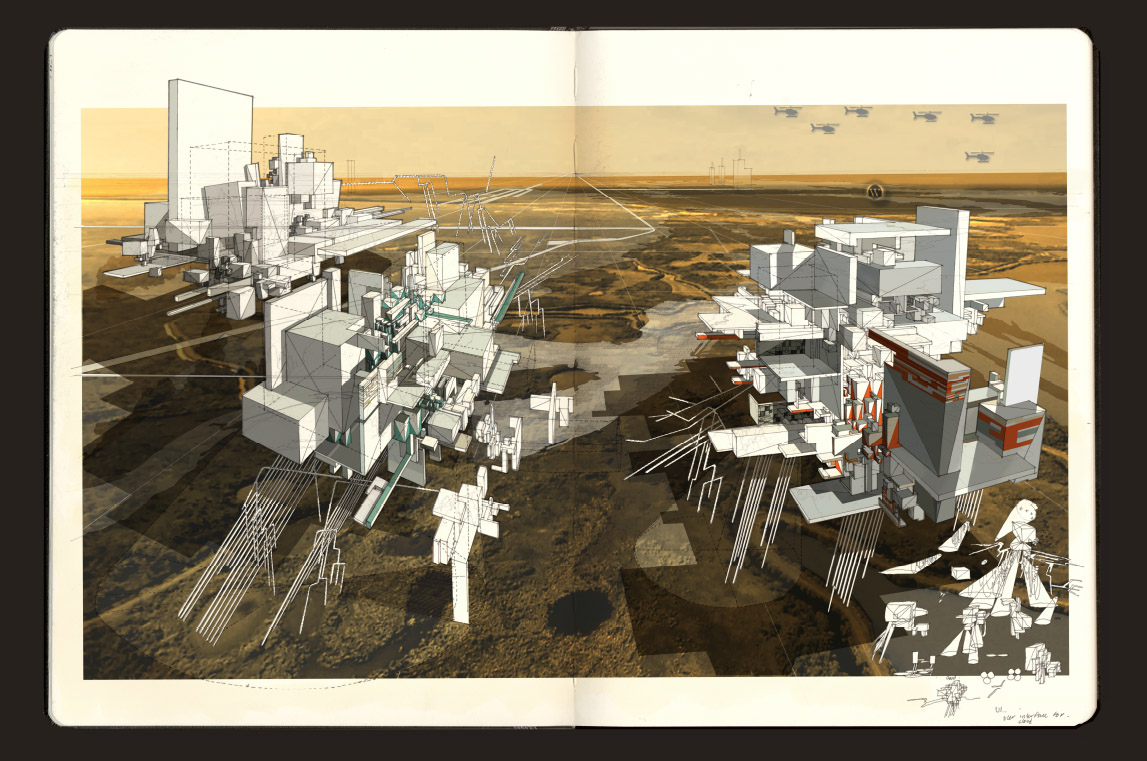
[Image: Collage of the lightning farm, by Farah Aliza Badaruddin at the Bartlett School of Architecture].
I should say that my own interest in these kinds of proposals is less in their future workability and more in what it means to see a technology taken out of context, picked apart for its spatial implications, and then re-scaled and transformed into a speculative work of landscape architecture. The value, in other words, is in re-thinking existing technologies by placing them at unexpected scales in unexpected conditions, simultaneously extracting an architectural proposal from that and perhaps catalyzing innovative new ways for the original technology itself to be redeveloped or used.
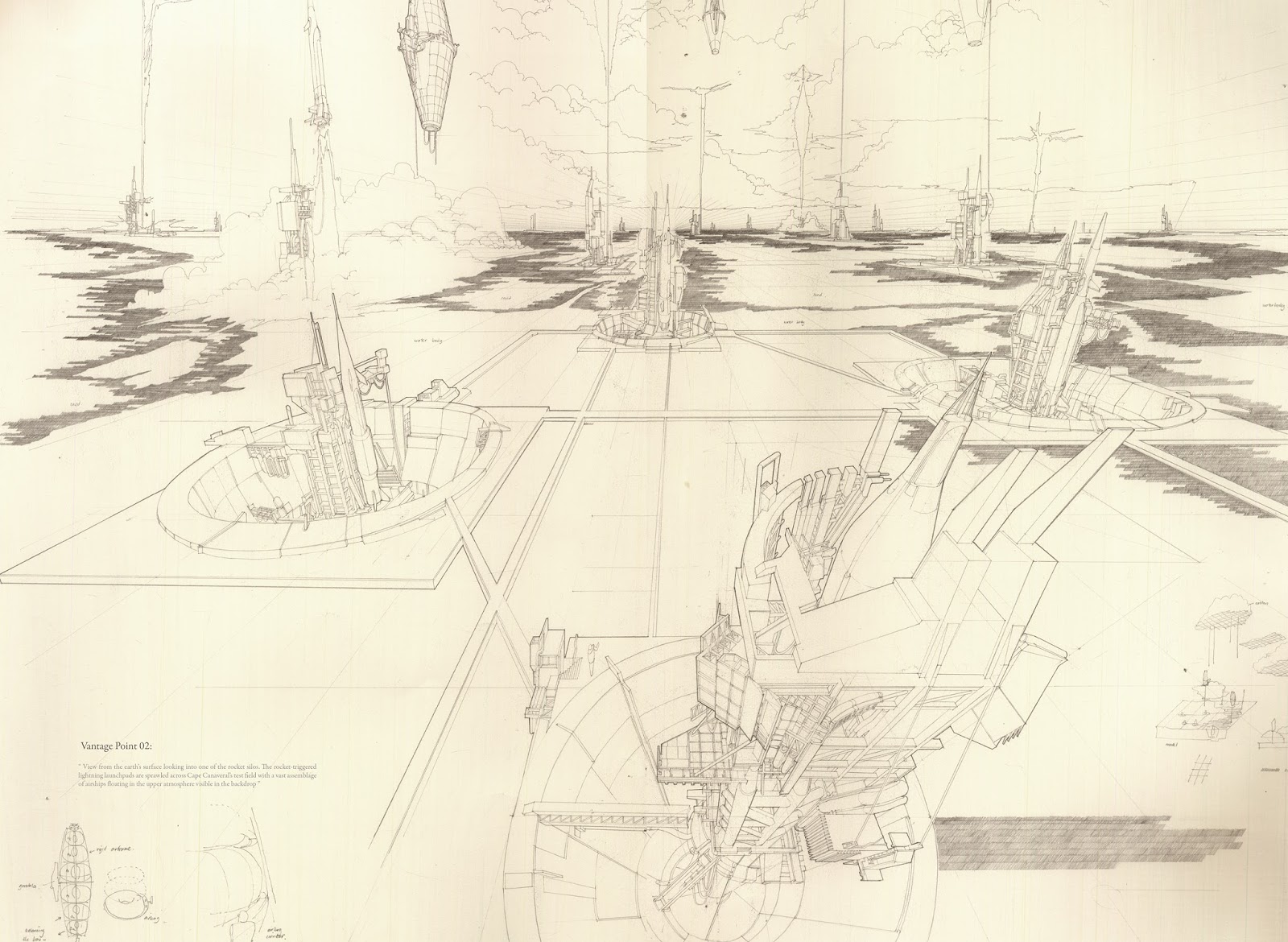
[Image: Farah Aliza Badaruddin].
It's not a question of whether or not something can be immediately realized or built; it's a question of how open-ended, fictional design proposals can change the way someone thinks about an entire field or class of technologies.
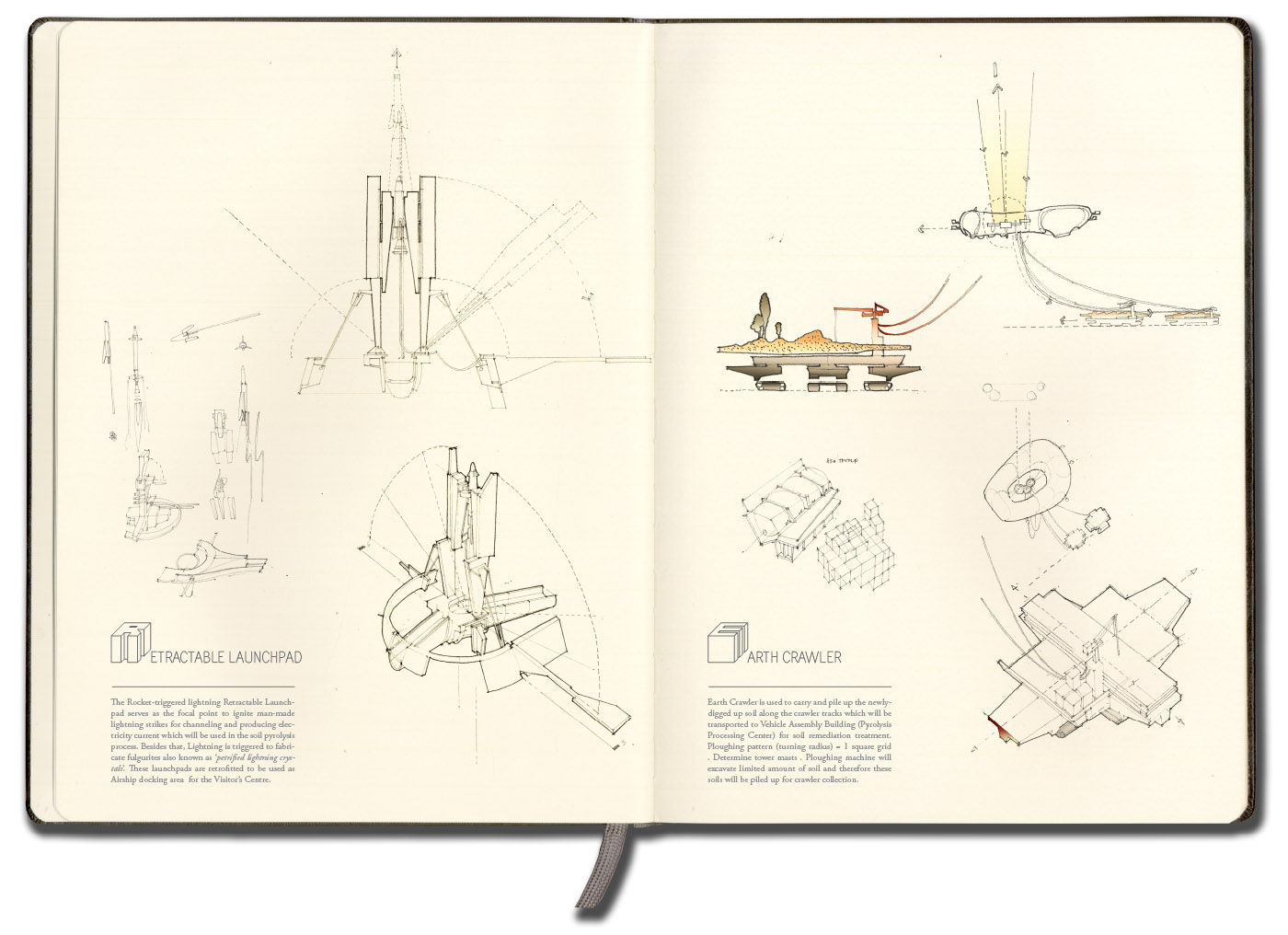
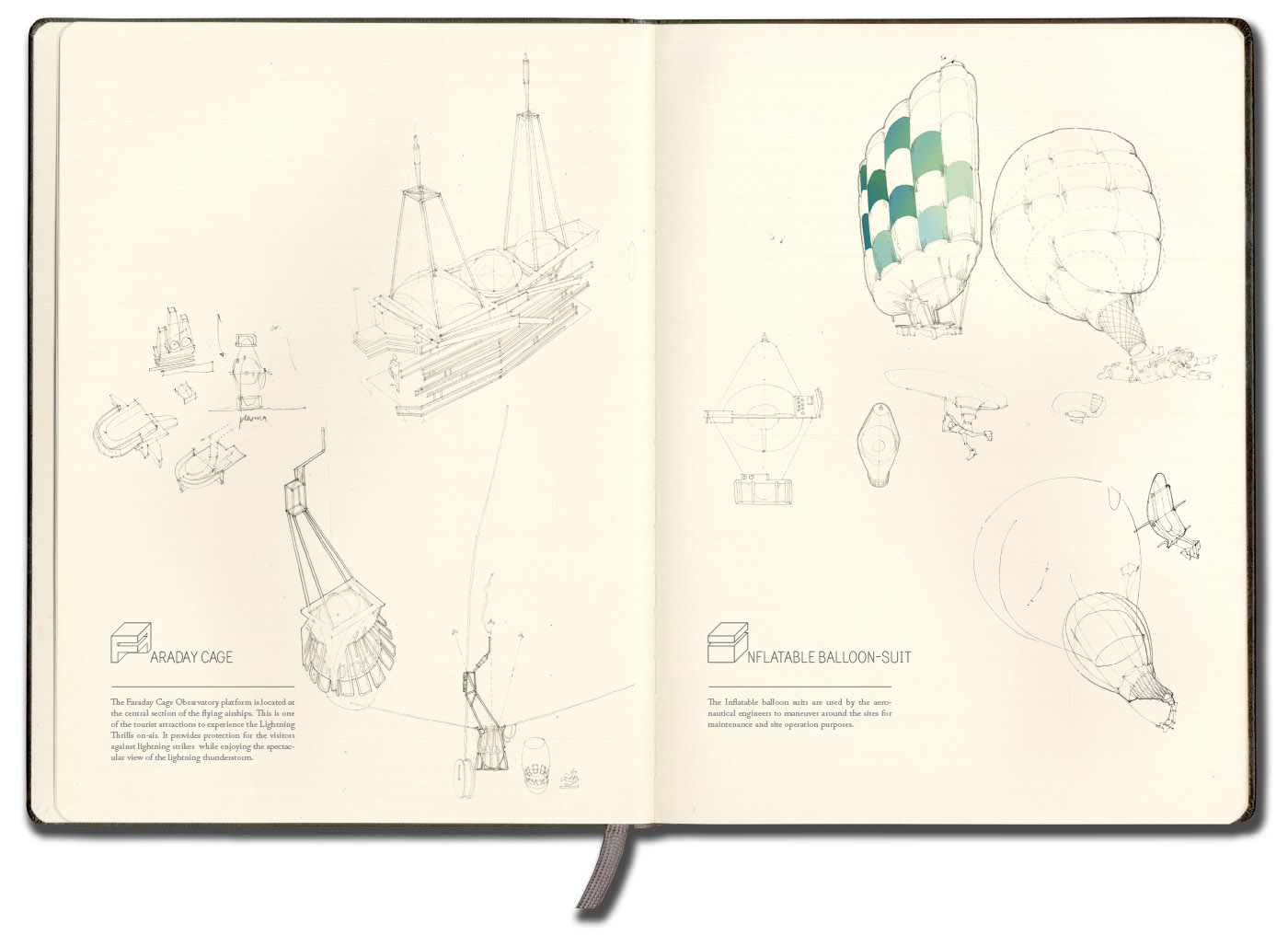
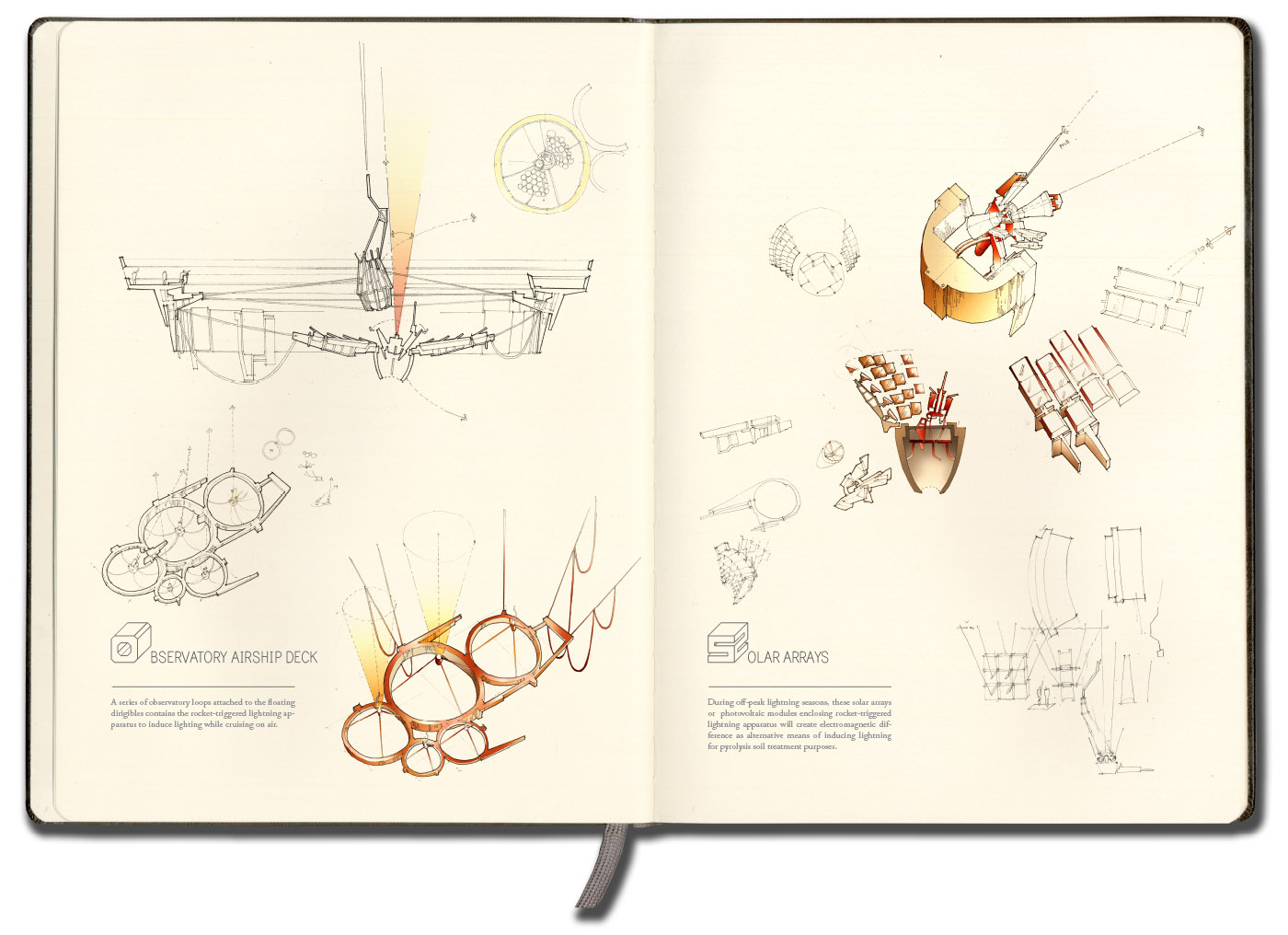
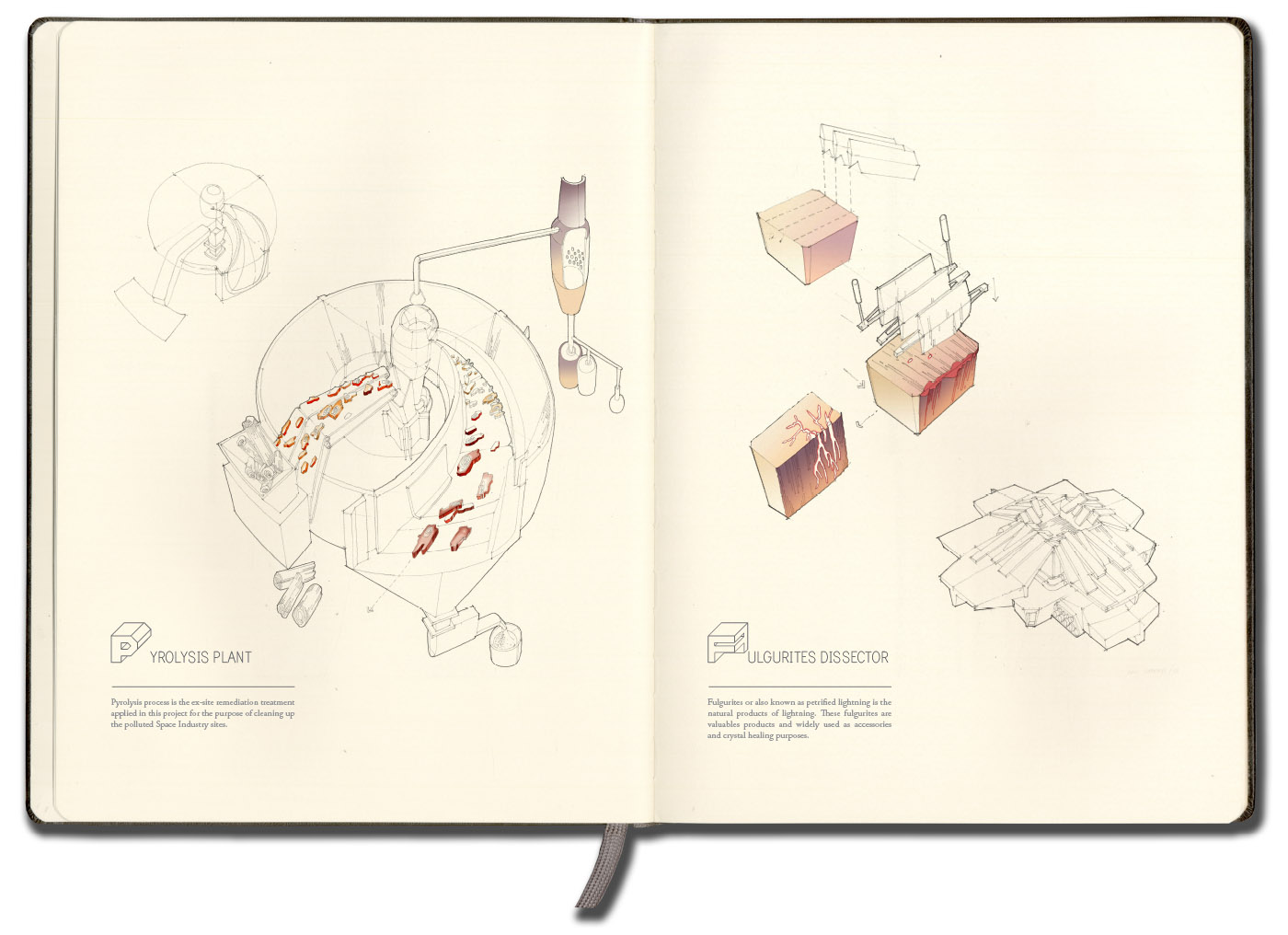
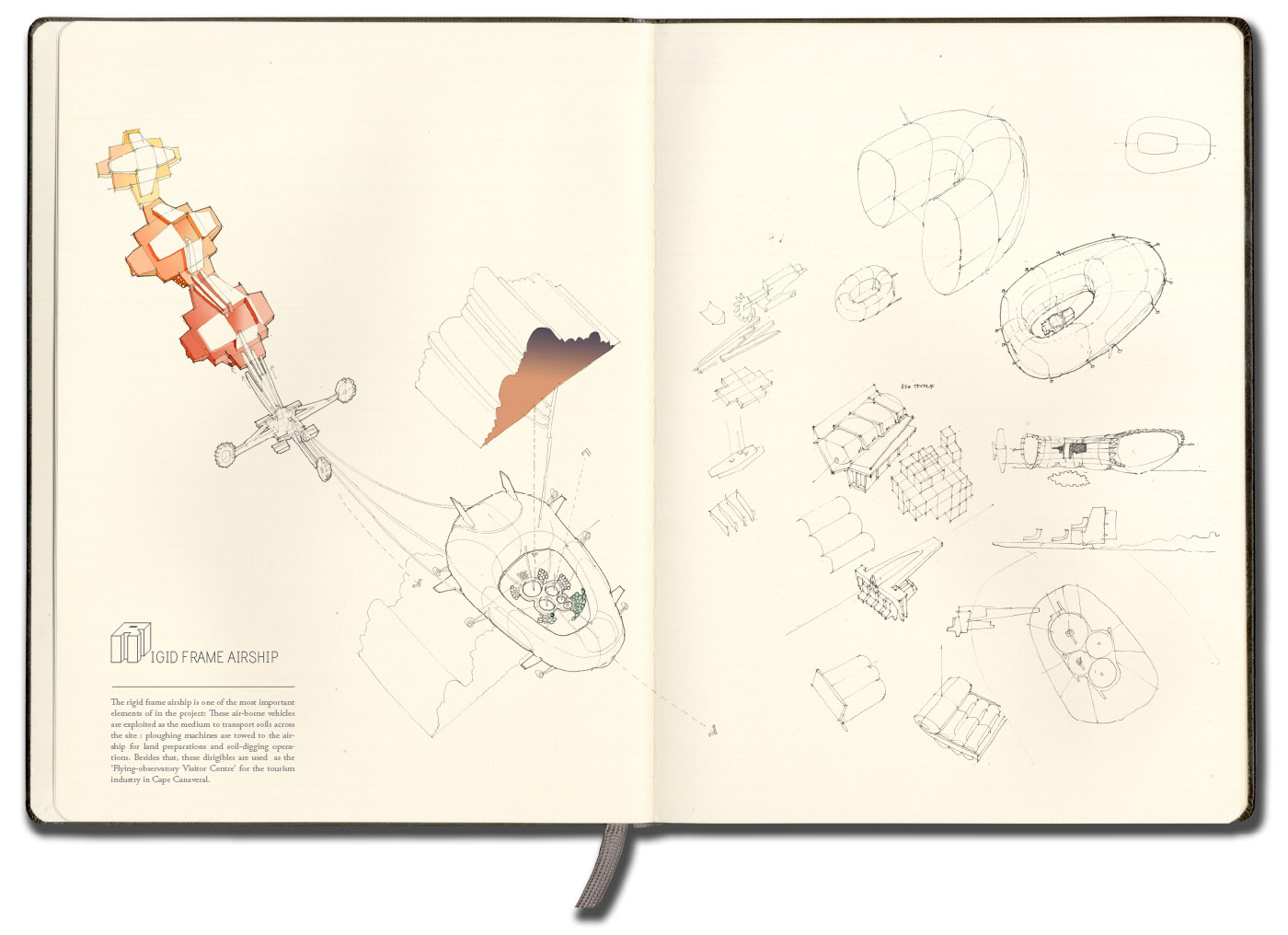
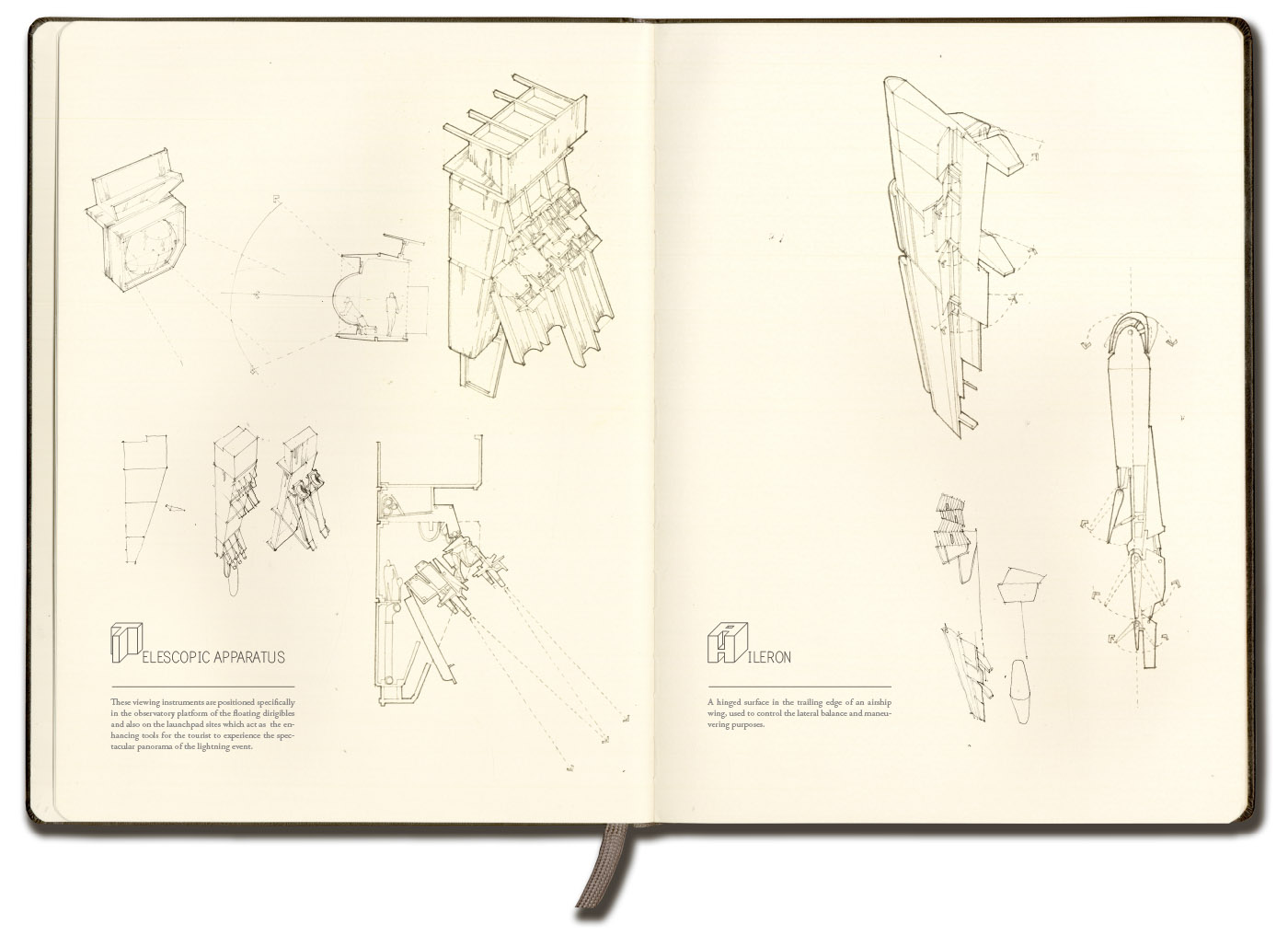
[Images: From a project by Farah Aliza Badaruddin at the Bartlett School of Architecture].
But I'll let Badaruddin's own extraordinary visual skills tell the story. Most if not all of these images can be seen in a much larger size if you open the images in their own windows; they're well worth a closer look—
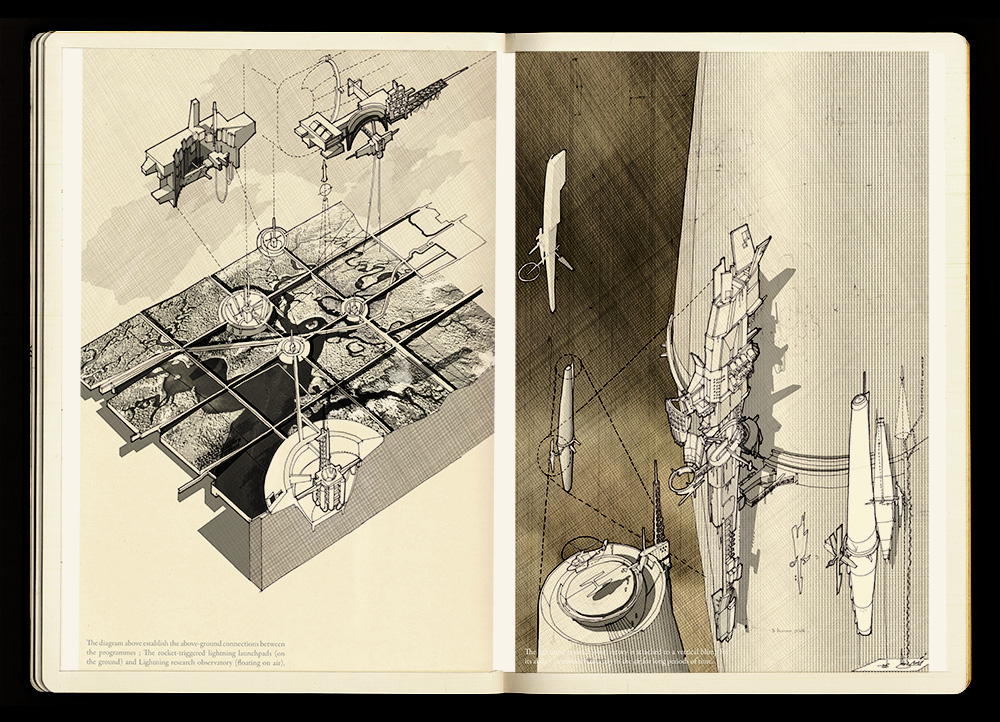
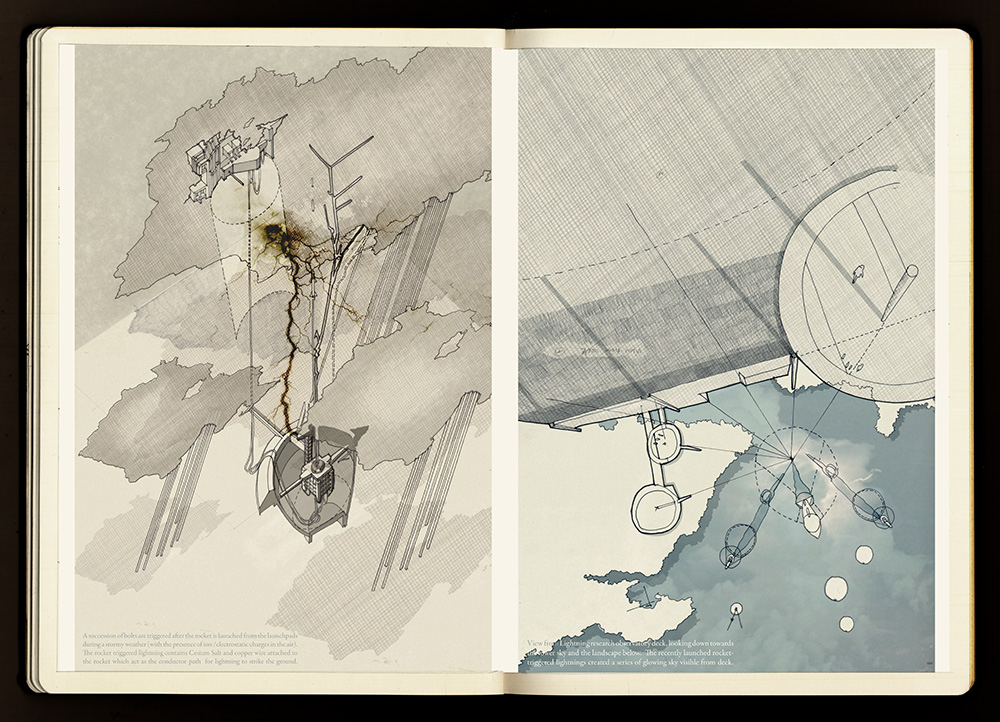
[Images: From a project by Farah Aliza Badaruddin at the Bartlett School of Architecture].
—including what amount to a short graphic novel telling the story of her proposed controlled-lightning landscape-decontamination facility.
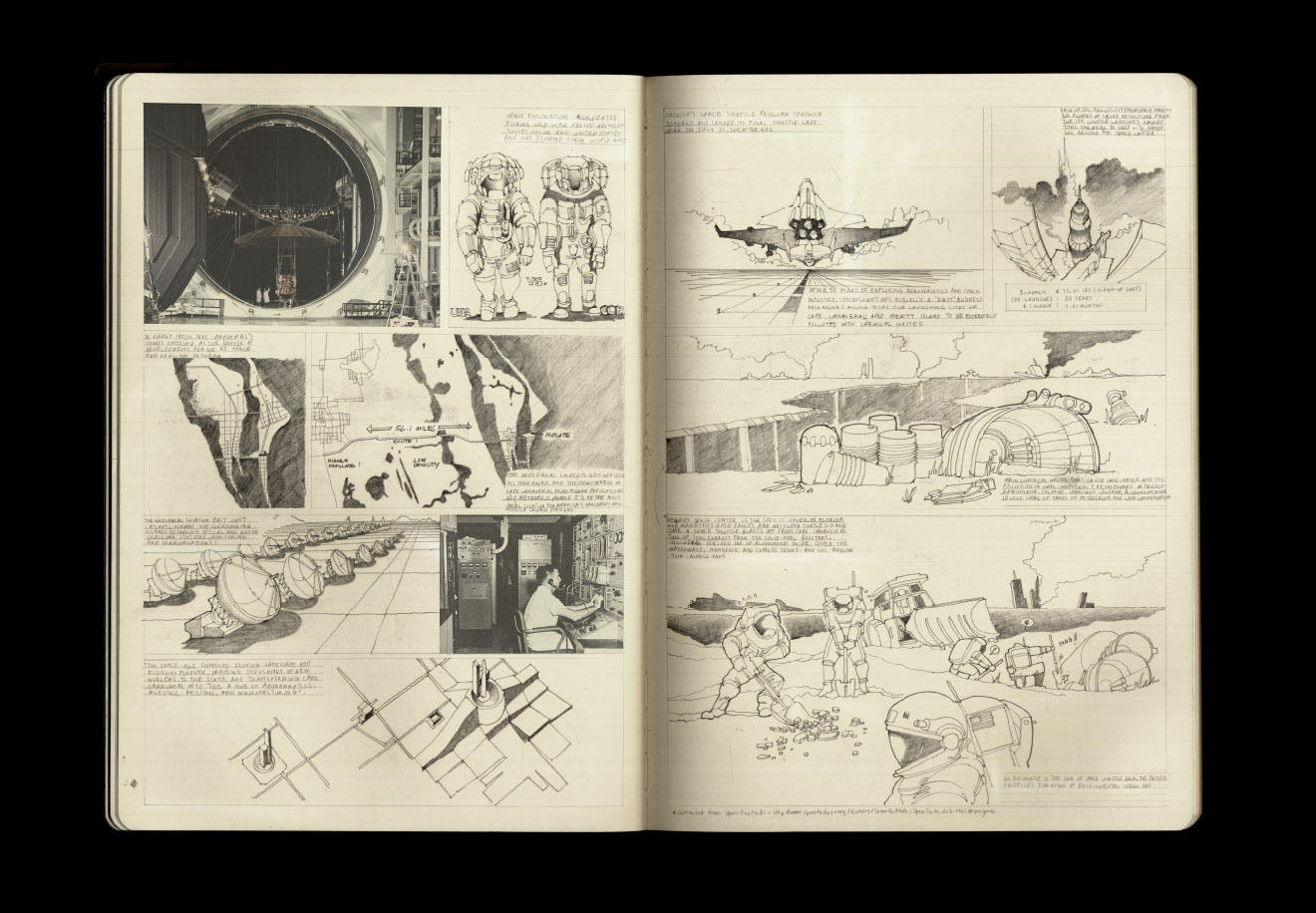
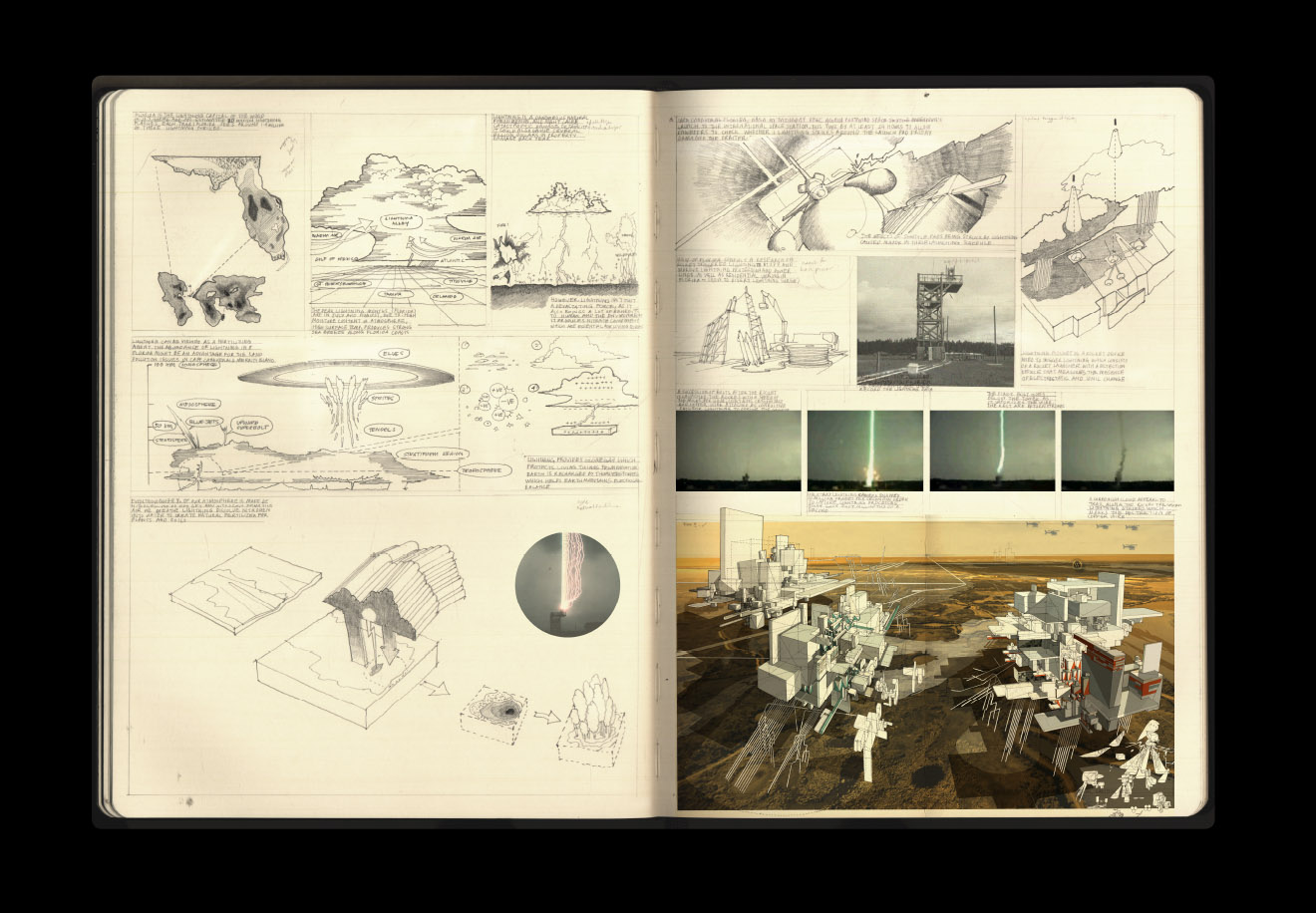
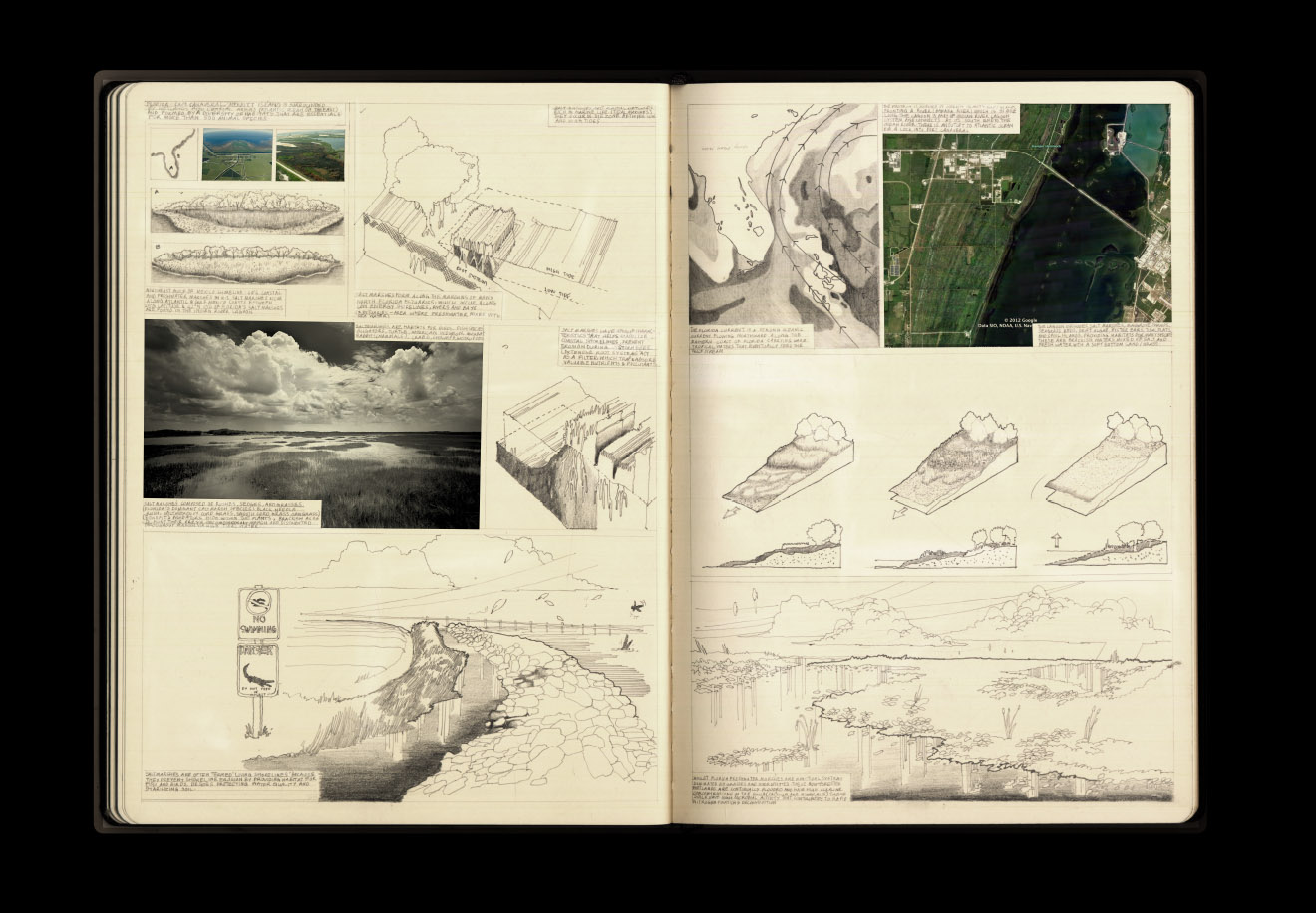
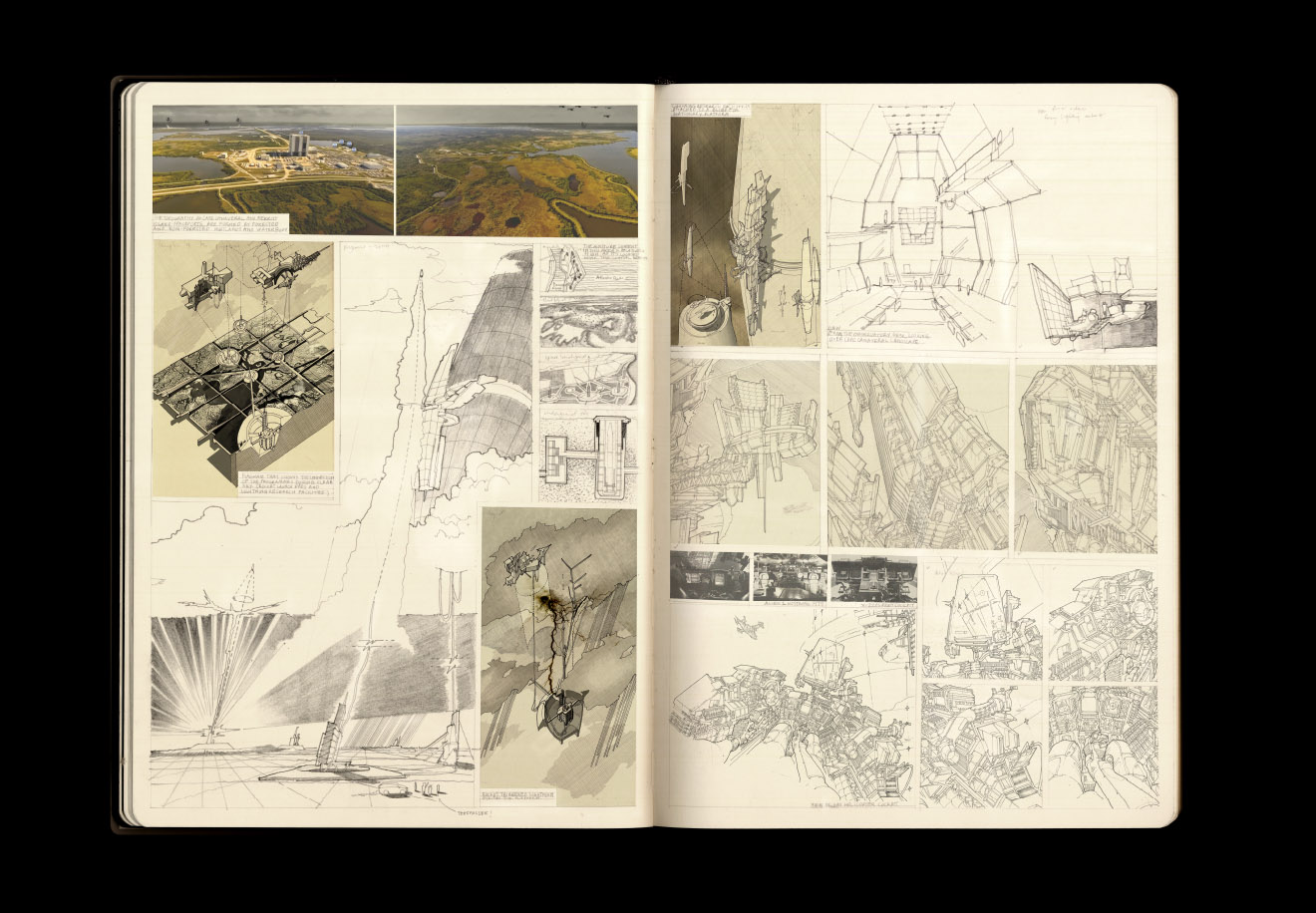
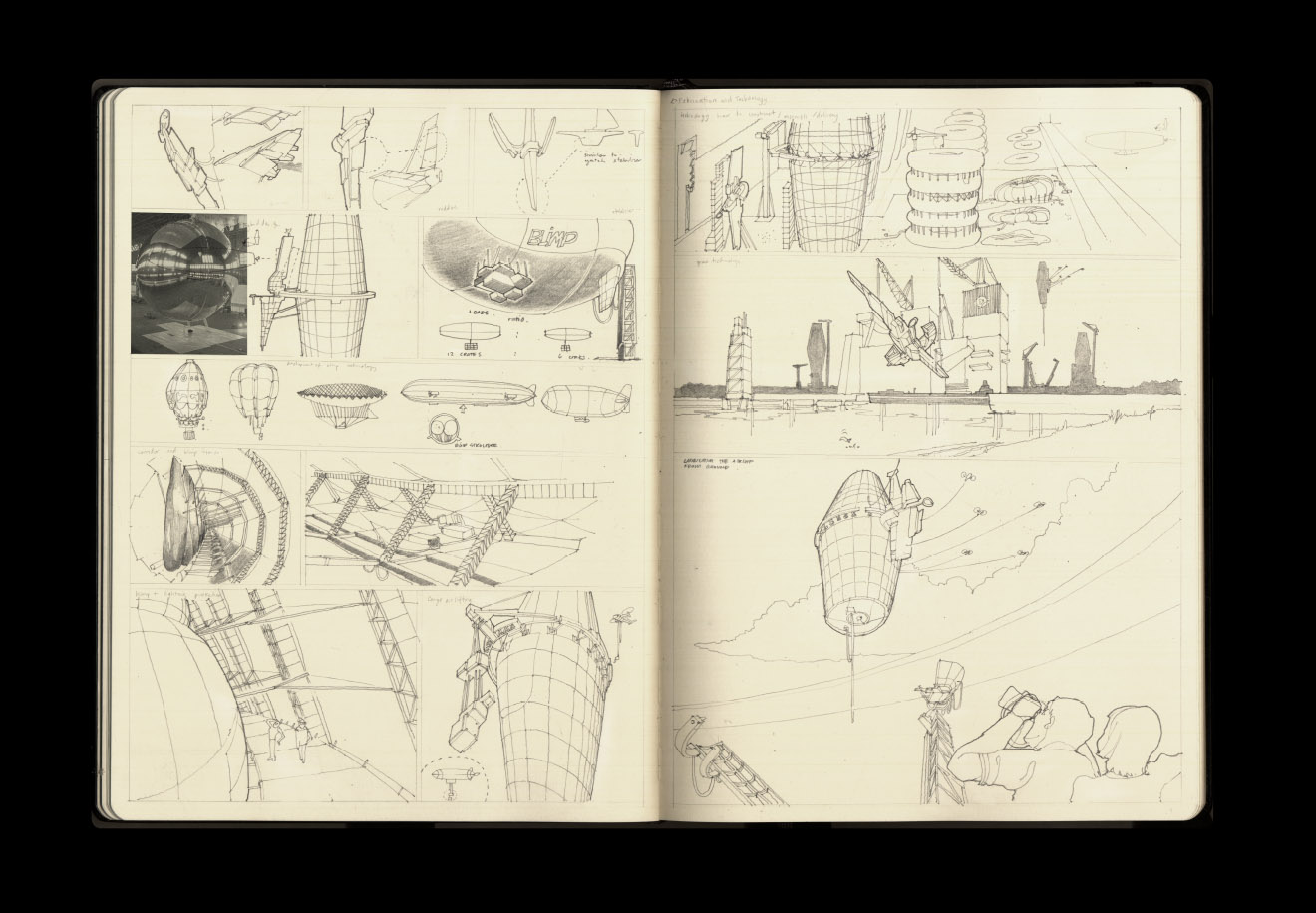
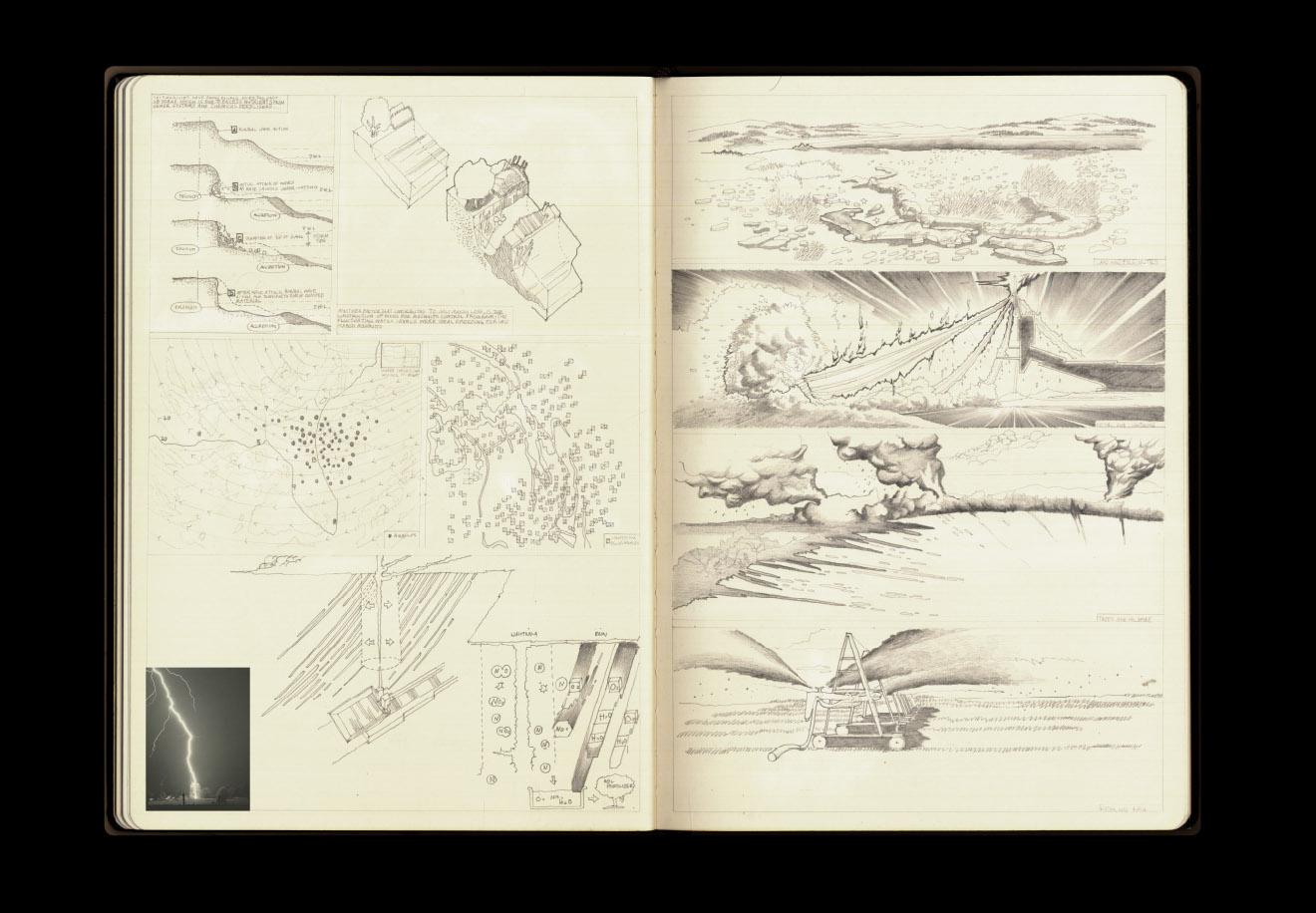
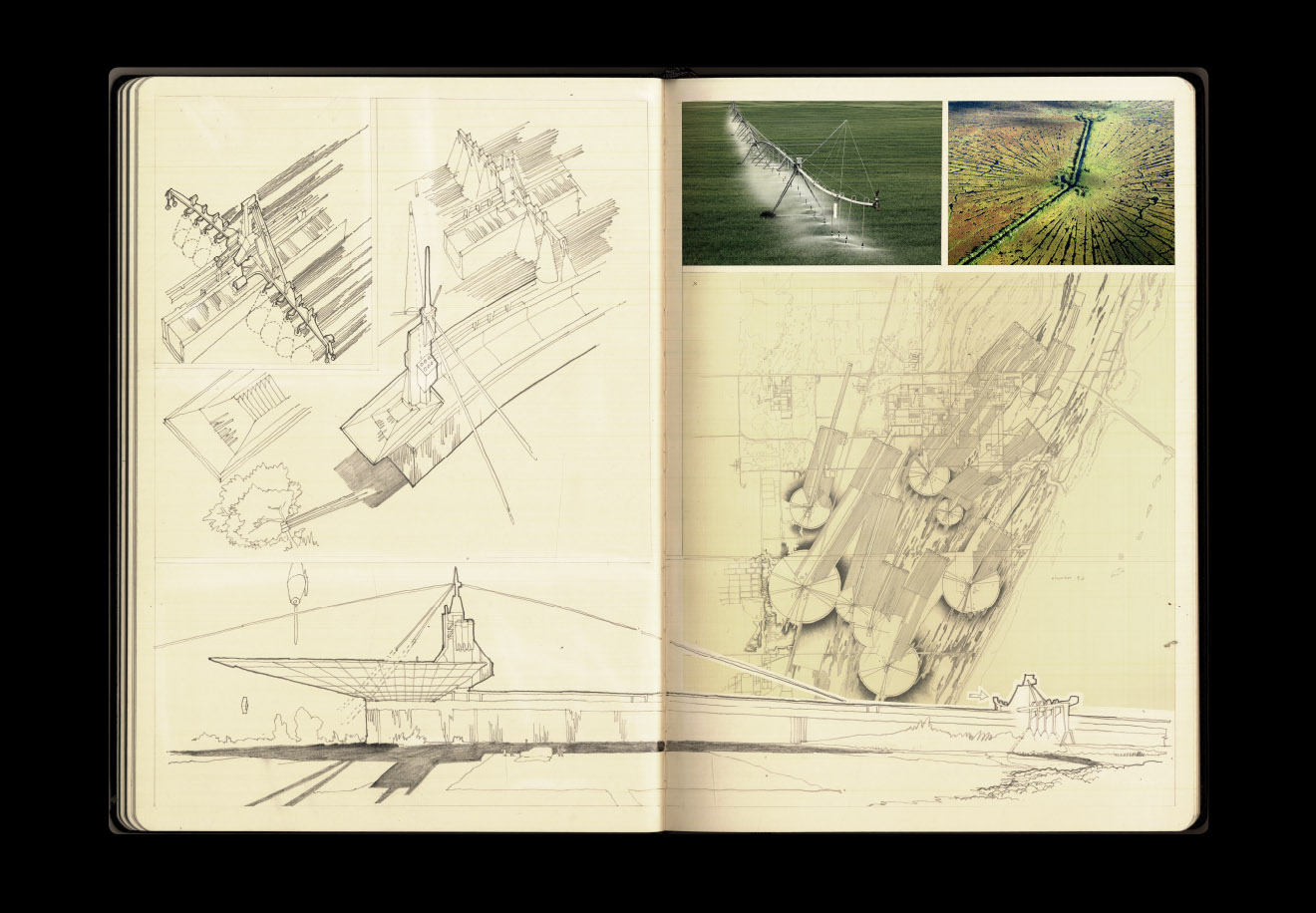
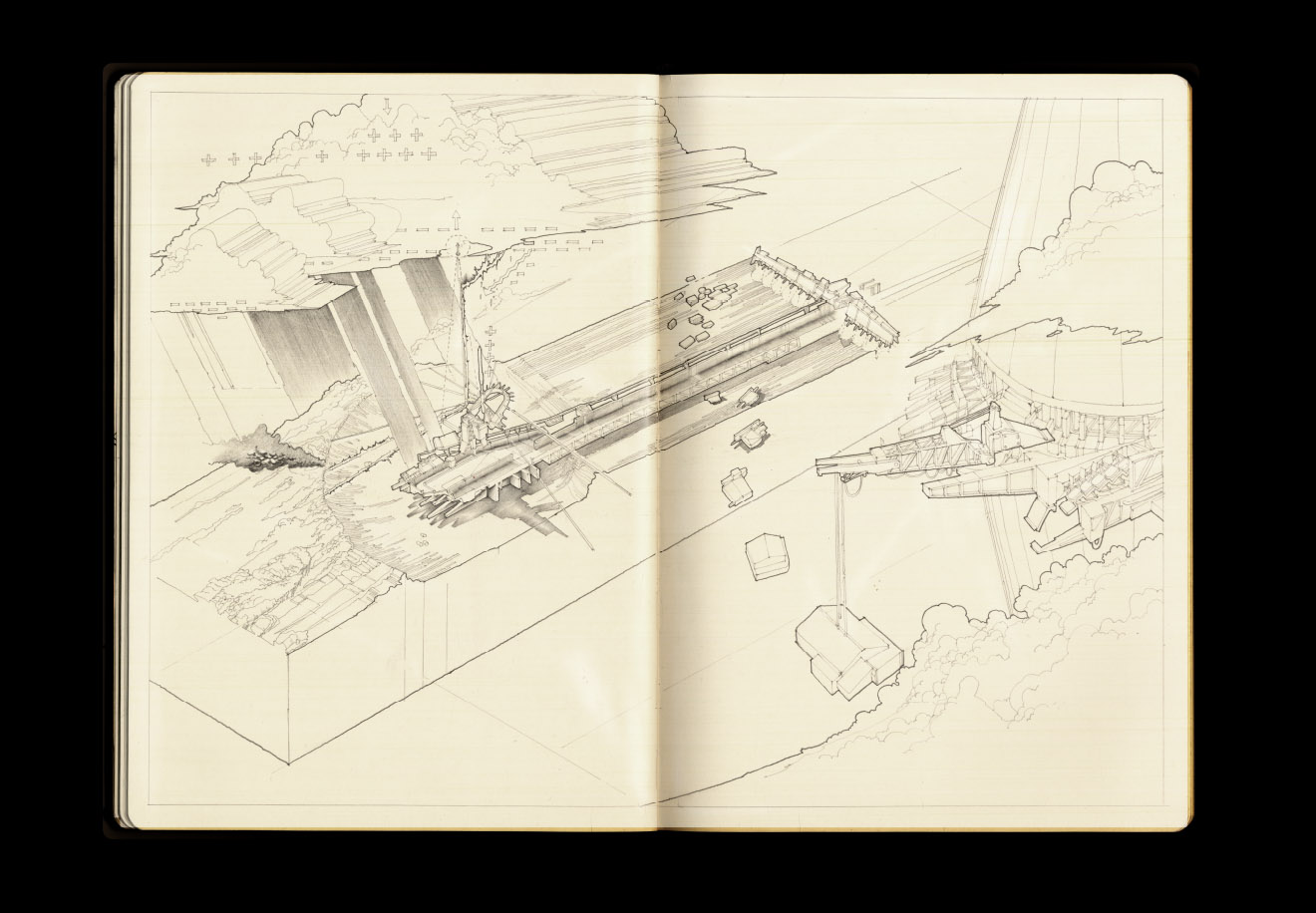
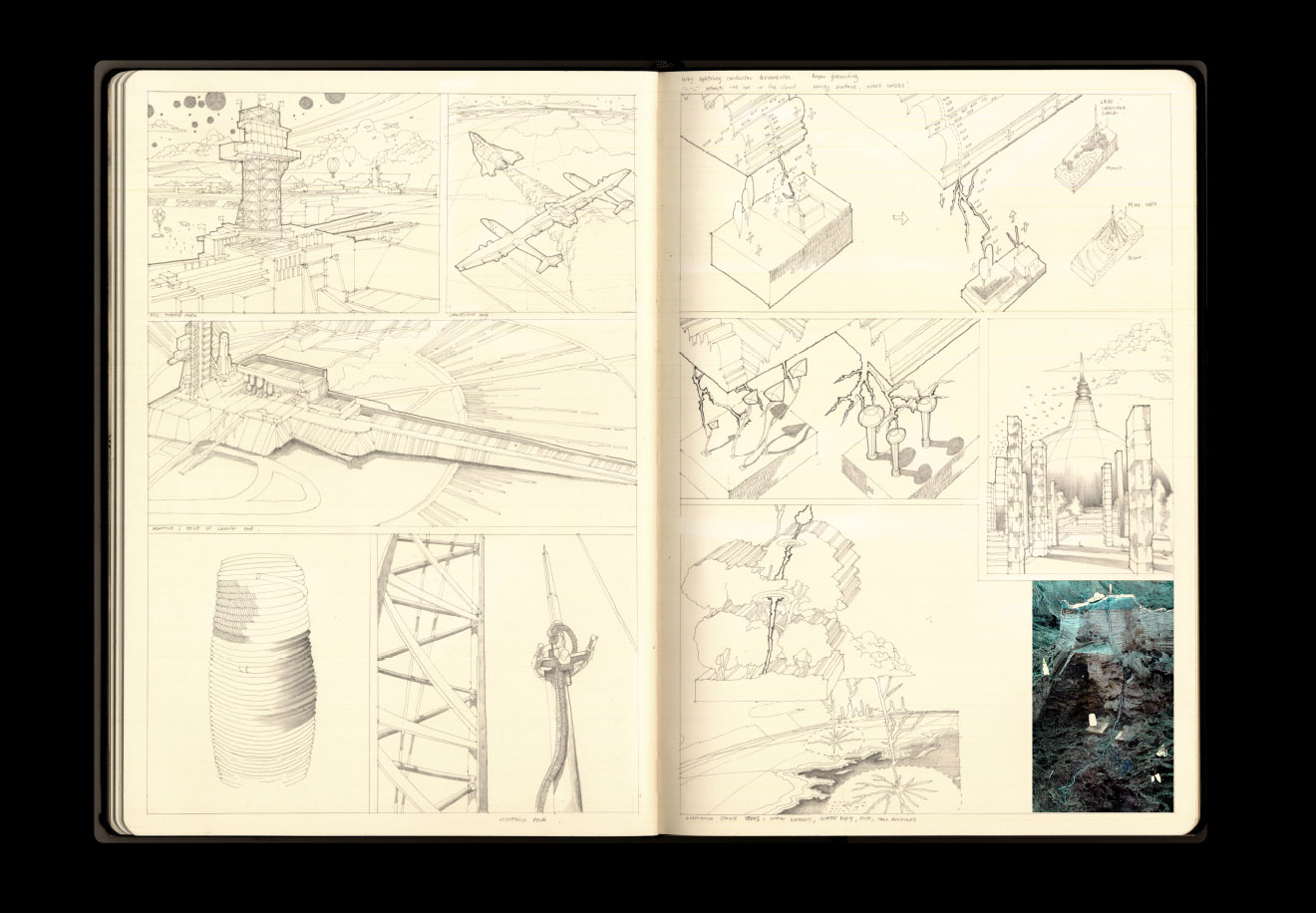
[Images: From a project by Farah Aliza Badaruddin at the Bartlett School of Architecture].
All in all, whether or not architecturally-controlled lightning storms will ever purify the land and water of south Florida, it's a wonderfully realized and highly imaginative project, and I hope Badaruddin finds more opportunities, post-Bartlett, to showcase and develop her skills.
Friday, January 18. 2013
The Cloud Machine – A Personalized Weather Modification Prototype
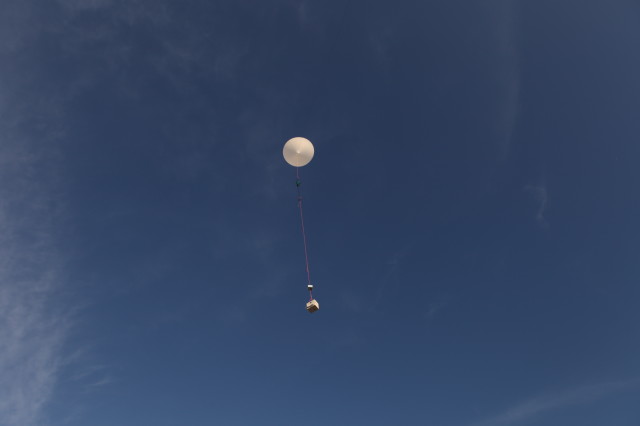
While airship construction is not generally within the purview of media artists, a recent project by Karolina Sobecka makes a compelling case for floating personalized weather modification devices up towards the stratosphere. The Cloud Machine is a composite weather balloon and rudimentary cloud seeding apparatus that can create small clouds and make subtle alterations to the atmosphere in the process.
More about it on Creative Applications.
Related Links:
Tuesday, December 04. 2012
The Coldscape
Via Cabinet
-----
By Nicola Twilley
More than three-quarters of the food consumed in the United States today is processed, packaged, shipped, stored, and sold under artificial refrigeration. The shiny, humming stainless steel box in your kitchen is just the tip of the iceberg, so to speak—a tiny fragment of the vast global network of temperature-controlled storage and distribution warehouses cumulatively capable of hosting uncounted billions of cubic feet of chilled flesh, fish, or fruit. Add to that an equally vast and immeasurable volume of thermally controlled space in the form of shipping containers, wine cellars, floating fish factories, international seed banks, meat-aging lockers, and livestock semen storage, and it becomes clear that the evolving architecture of coldspace is as ubiquitous as it is varied, as essential as it is overlooked.
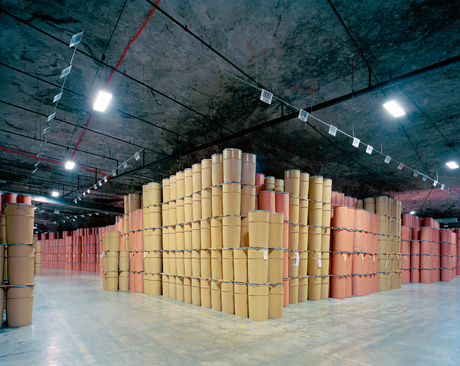
(...)
More about it and about a "perpetual winter" on Cabinet's website.
Related Links:
Monday, November 05. 2012
Geoengineering Could Be Essential to Reducing the Risk of Climate Change
-----
Using technology to cool the planet may be the only way to deal with the greenhouse gases already in the atmosphere, argues scientist David Keith.
By Kevin Bullis

David Keith spoke at MIT Technology Review’s EmTech conference this week.
Geoengineering—using technology to purposefully change the climate—is the only option for reducing the risk of climate change from greenhouse-gas emissions in the next few decades, says David Keith, a professor of public policy and applied physics at Harvard University. And he says that if it’s done in moderation, it could be much safer than some experts have argued. In fact, says Keith, effective methods of geoengineering are so cheap and easy that just about any country could do it—for better or worse.
Keith, speaking this week at MIT Technology Review’s annual EmTech conference, says it is already too late to avoid climate changes by reducing carbon emissions alone. The carbon dioxide that’s been released into the atmosphere by burning fossil fuels is already likely to cause significant harm, such as raising temperatures enough to hurt crop yields in many places. “If you want to, say, really stop the loss of Arctic sea ice or stop heat-stress crop losses over the next few decades, geoengineering is pretty much the only thing you can do,” he says (see “Why Climate Scientists Support Geoengineering Research”).
One of the main objections to geoengineering is that the measures that might be taken to cool the planet won’t exactly offset the effects of carbon dioxide, so they could actually make things much worse—for example, by altering patterns of precipitation. Keith says recent climate models suggest that injecting sulfate particles into the upper reaches of the atmosphere might not affect precipitation nearly as much as others have warned.
“I propose that you start in about 2020, and you start very, very gradually increasing your amount of sulfate engineering so that you cut about in half the rate of warming,” he says. “Not eliminate it, but cut it about in half. Cutting it in half is a big benefit.”
One of the benefits could be increased crop production. Though some critics have worried that geoengineering would alter monsoon patterns that are key to agriculture in India, Keith says moderate geoengineering could actually boost crop productivity there by 20 percent, in part by reducing temperatures.
Keith and some of his colleagues recently hired engineers to estimate how much one approach to sulfate injection might work, and how much it might cost. It could be done at first with existing airplanes—certain business jets can fly high enough to inject the particles into the upper atmosphere. Eventually we would need new planes that can fly higher. All in all, once the procedure is scaled up it would cost about a billion dollars a year and require about 100 aircraft. That’s cheap enough for most countries to pull off on their own.
The fact that it’s easy isn’t necessarily a good thing, Keith says. There’s the potential that if one country does it, another might blame that country—rightly or wrongly—for ensuing bad weather (see “The Geoengineering Gambit”).
And there are also real concerns about the impact sulfates might have on the atmosphere (see Geoengineering May Be Necessary, Despite Its Perils). It’s known that sulfates can be involved in reactions that deplete the ozone layer. As the earth warms, water vapor levels are increasing, which could exacerbate the problem. Keith is proposing a test to discover quantitatively just what the effect of the injections could be. He would introduce small clouds of sulfate and water vapor into the stratosphere using balloons, and then carefully measure the reactions that take place.
And Keith acknowledges a concern many have had about geoengineering: that using it to offset problems from climate change will reduce the incentive to tackle the greenhouse-gas emissions at the root of the problem. Even if geoengineering is employed, reducing emissions will still be important. Sulfate injection does nothing to address the ocean acidification associated with increased levels of carbon dioxide in the atmosphere. And if emissions continue to grow, ever-increasing amounts of sulfate will be needed.
But Keith thinks the potential benefits might be worth the dangers. “We don’t know enough yet to start,” he says. “But the current balance of evidence is that doing this really would reduce risks. And for that reason, we’ve got to take it seriously. It really would be reckless not to look at something that could reduce risk like this could.”
Wednesday, December 07. 2011
The Rounds
Via BLDGBLOG
-----
(...)
5) "Imagine a lush forest: silent but for the chirping of birds flying through a dense canopy overhead, and damp, aromatic earth underfoot. Now picture a mountain of incinerated trash, 12 million tons of what was once a toxic heap of rotting fish and vegetables, old clothes, broken furniture, diapers and all manner of discarded items." This describes a new project by architect Tadao Ando called the Sea Forest. The Sea Forest "will transform 88 hectares of reclaimed land, a 30-meter deep mound of alternating layers of landfill, into a dense forest of nearly half a million trees" in Tokyo Bay. Ando adds that it is also an experiment in climate-engineering, or weather control as the future of urban design: "not only will [the forest] become a refreshing retreat for stressed out city workers, it will also create a cool ocean breeze to sweep through the capital and cool its sweaty denizens in summer."
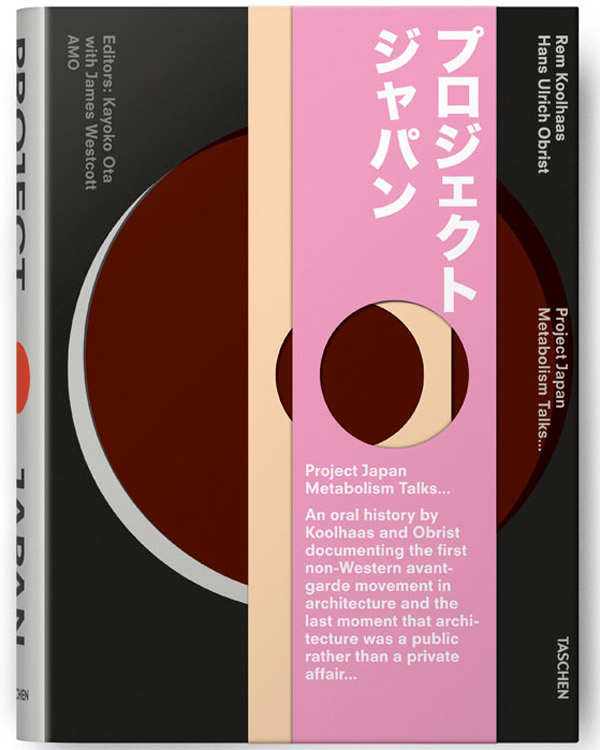
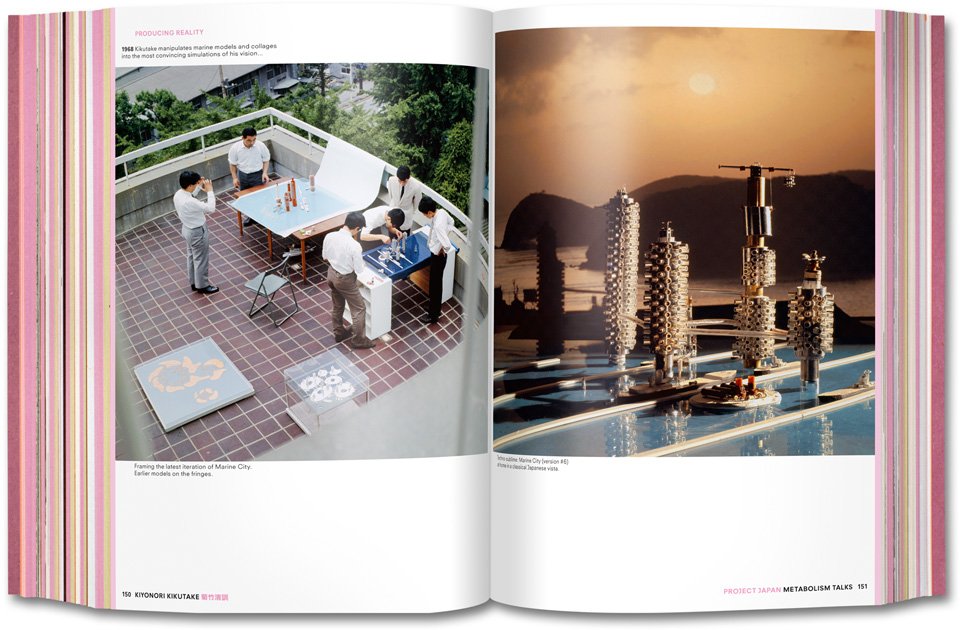


 [Images: Spreads from Project Japan, courtesy of Taschen].
[Images: Spreads from Project Japan, courtesy of Taschen].
6) The new book Project Japan by Rem Koolhaas and Hans Ulrich Obrist is an incredible document, in both physical and intellectual terms. The design, by Irma Boom, is gorgeous, and the contents—consisting of long, illustrated interviews with such figures as Arata Isozaki, Kenzo Tange's Tange Lab, Kiyonori Kikutake, Kisho Kurokawa, and many others, scattered amongst historical imagery and present-day site photos—offer a fascinating oral history of the Metabolist movement. As Koolhaas sums it up, Metabolism offered "a manifesto for the total transformation of the country" based on three specific principles. Still quoting Koolhaas:
a) The archipelago has run out of space: mostly mountainous, the surfaces fit for settlement are subdivided in microscopic, centuries old patchworks of ownership
b) Earthquakes and tsunamis make all construction precarious; urban concentrations such as Tokyo and Osaka are susceptible to potentially devastating wipeouts [ed. note: cf. today's calls for a "back-up Tokyo"]
c) Modern technology and design offer possibilities for transcending Japan's structural weakness, but only if they are mobilized systematically, almost militaristically, searching for solutions in every direction: on the land, on the sea, in the air...
Architecture thus becomes the literal geopolitical extension of the state, constructing new territory—such as floating forests and artificial islands—over which to govern. It's a kind of proactive gerrymandering, we might say: not redesigning the district map, but constructing new districts. In any case, I recommend the book.
(...)
Related Links:
Saturday, December 03. 2011
Solar energy
Personal comment:
This is a quite beautiful object. Architectured weather and light effects around the convergent point of the solar beams. 800 °C around the top!
Thursday, November 17. 2011
Should Scientists Seed the Sky With Chemicals?
Via GOOD
-----
by Sarah Laskow

Not long ago, geoengineering was a verboten topic. It’s the sort of idea that dips deep enough into the wells of human ambition and hubris that it seems too dangerous to even consider. In the words of a Woodrow Wilson Center report, geoengineering “involves intentional, large-scale interventions in the Earth’s atmosphere, oceans, soils or living systems to influence the planet’s climate”—in other words, a man-made fix to the man-made problem of climate change. In its most extreme forms, geoengineering could mean seeding the sky with chemicals to deflect sunlight away from Earth and change the sky’s color from blue to white. Or it could mean blocking solar energy by sending reflectors into orbit that, in certain configurations, would banish the Milky Way from the night sky. It's easy to see why such scenarios would make scientists nervous.
Yet there is a growing belief in the Washington think-tank world that although geoengineering is not an optimal solution to climate change, it may be a necessary one. In the past couple of months, both the Wilson Center and the Bipartisan Policy Center have released reports that suggest further research into geoengineering. Both organizations emphasize that other fixes to climate change—mitigation through energy innovation and adaptation to harsher conditions—are preferable, but they conclude that geoengineering might be the best option to deal with the extreme threats posed by climate change to human living conditions.
One the first reports on geoengineering, published in 1965, proposed it as a climate solution without imagining that decreasing coal or oil use might be a more reasonable approach. Since that era, though, the magnitude of climate change and the limits of human ingenuity have become clear. The Wilson Center cautions that faith in geoengineering may be misplaced because "we may know too little about the Earth's geophysical and ecological systems to be confident we can engineer the climate on a planetary scale."
The Wilson Center favors research into less risky forms of geoengineering, like siphoning carbon out of the atmosphere and storing its elsewhere. A few similar techniques—better soil management and reforestation—double as mitigation strategies already under investigation by climate researchers. The Bipartisan Policy Center, meanwhile, is more gung-ho about the more radical forms of geoengineering, the “solar radiation management” strategies that include seeding the sky with chemicals, though they emphasize that mitigating risk is a priority.
The appeal of geoengineering is obvious: It’d be easy compared to the effort needed to wean the country off coal and oil altogether. That’s one reason a slew of conservative think thanks, from the American Enterprise Institute to the Heartland Institute, have supported it for years. But it should be a last-ditch resort. The scary part is that climate change could get bad enough to warrant such measures. Earlier this month, the International Energy Agency reported that the world has just five years left to avoid catastrophic climate change. It’s still possible to turn away from a future where serious people are advocating for a white-sky world. But there’s not much time left.
Photo via (cc) Flickr user dcysurfer/Dave Young
Personal comment:
While I agree with the fears of Sarah Laskow about geo-engineering the planet, I want also to add this comment: we've already geo-engineered the planet for decades! Even so it was not an intended one (or was it?), 7 billion humans with their food production systems, architectures and travel infrastructures, energy production, factories, etc. are a very strong geo-engineering force, especially in the developed countries! It is no more a natural Earth we are living in, but a man transformed one (the famous "anthropocene" described by some), in its very essence (up to the quality of the air we are breathing).
So, would a radical "geo-engineering" solution be to go back to 1-2 billions humans on Earth or less within the next 200 years (like we were 200 years ago, before the industrial revolution)? Is it the sustainable approach of reducing this and that, trying to find new ecological solutions to many different problems, without asking this question of population? Should we rather change our economy or is it a headlong rush that is characterized by the geo-engineering approach?
This sound like a real crossroads question ...
Wednesday, November 16. 2011
Project Ice Shield
 [Image: "L.A. Ice" by Victor Hadjikyriacou, produced for Unit 11 at the Bartlett School of Architecture, part of last year's Landscape Futures Super-Workshop].
[Image: "L.A. Ice" by Victor Hadjikyriacou, produced for Unit 11 at the Bartlett School of Architecture, part of last year's Landscape Futures Super-Workshop].
The city of Ulan Bator, Mongolia, will attempt to keep itself cool over the summer by way of a kind of artificial glacier.
According to the Guardian, this "geoengineering trial" will try to "'store' freezing winter temperatures in a giant block of ice that will help to cool and water the city as it slowly melts during the summer." Project directors "hope the process will reduce energy demand from air conditioners and regulate drinking water and irrigation supplies." The cool air will presumably be pumped through the city via a continuous and monumental network of ducts.
So how will it work?
The project aims to artificially create "naleds"—ultra-thick slabs of ice that occur naturally in far northern climes when rivers or springs push through cracks in the surface to seep outwards during the day and then add an extra layer of ice during the night. Unlike regular ice formation on lakes—which only gets to a metre in thickness before it insulates the water below—naleds continue expanding for as long as there is enough water pressure to penetrate the surface. Many are more than seven metres thick, which means they melt much later than regular ice.
Fascinatingly, naleds have already been used as foundations for infrastructural projects elsewhere; in North Korea, for instance, the Guardian reports, the military has utilized naleds "to build river crossings for tanks during the winter and Russia has used them as drilling platforms."
The specific architectural technique of the ice bridge can be explored in this helpful PDF from the Alaska Division of Forestry. Quoting at great length, here are the skills you need to bridge remote rivers with artificially augmented ice packs, should such a scenario ever befall you or your loved ones. These are "guidelines for ice-bridge construction":
The ideal site has the following characteristics: deep, narrow, slow flow in a single straight channel with gradual approaches to the ice; no tributary streams, creeks or lakes immediately upstream; and it is located near an existing road network. The site should also be free of warm springs and sand bars and not subject to major snow drifting. Being downstream of riffles/rapids may be conducive to supercooling and frazil ice formation that might accelerate ic e formation and growth at the bridge site. (...) Once natural ice cover has progressed across the channel thick enough to bear the weight of personnel and light equipment, existing snow cover is removed to accelerate ice growth at the bottom of the ice sheet. Variation exists in whether snow is removed or just compacted. Snow removal is recommended on upstream and downstream sides of the road for a distance of 23-30 meters (75-100 feet) as well as on the road itself. Subsequent to ice growth in response to snow removal, surface flooding is recommended to build up ice thickness on the road surface. (...) Lateral barriers of snow, logs or boards are used to contain floodwater on the road surface. Water should be applied by layering, allowing full freezing of previous water applications before the next. Conflicting recommendations exist as to whether brush or logs should be incorporated into the ice. One study did document the increase in ice strength after incorporating geo-grid material during the ice buildup process. A regular regime of ice drilling and monitoring of ice thickness is recommended.
If you want something a little more hi-tech, on the other hand, the U.S. Army Cold Regions Test Center has slowly been amassing insight into the construction of ice roads and ice bridges.
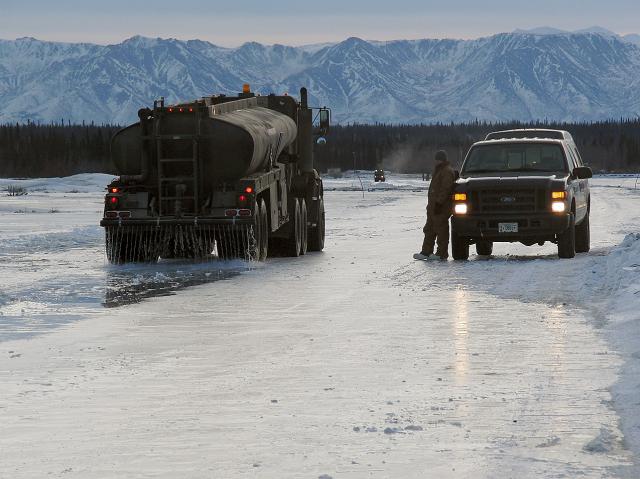 [Image: "A water truck passes over the ice road spreading a thin layer of water to thicken the ice so it can support heavy equipment transport"; photo courtesy of the U.S. Army].
[Image: "A water truck passes over the ice road spreading a thin layer of water to thicken the ice so it can support heavy equipment transport"; photo courtesy of the U.S. Army].
"Building an ice bridge/road takes a lot of time, hard work and favorable weather conditions," the Army reports. "The water must be frozen down to the riverbed, which requires breaking the ice down to the bottom and allowing it to freeze from the bottom up. The Engineers had to pump thousands of gallons of water onto the bridge/road to get the ice thick enough to support heavy equipment, while at the same time smoothing it out so vehicles could drive across it easily." The engineers involved in this particular story "established an ice bridge/road that was 28 inches thick in the beginning of January. With work scheduled to continue through the end of February, the engineers will add another 2.5 inches of ice every day."
And, as it happens, these experimental ice bridges grown by military personnel in the Arctic, like something out of Norse mythology, are a regular occurrence every winter.
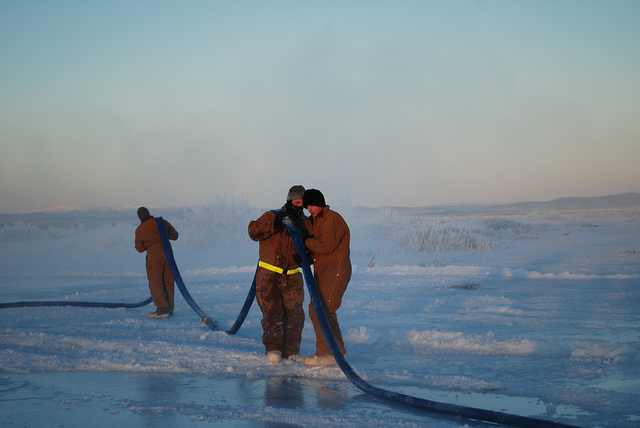 [Image: "Soldiers from the 6th Engineer Battalion, Fort Richardson, Alaska, clear water lines during construction of an ice bridge at the U.S. Army Cold Regions Test Center at Fort Greely, Alaska, Jan. 12, 2011." Photo by Sgt. Trish McMurphy, U.S. Army Alaska Public Affairs Office].
[Image: "Soldiers from the 6th Engineer Battalion, Fort Richardson, Alaska, clear water lines during construction of an ice bridge at the U.S. Army Cold Regions Test Center at Fort Greely, Alaska, Jan. 12, 2011." Photo by Sgt. Trish McMurphy, U.S. Army Alaska Public Affairs Office].
This year, for instance, the story repeated itself:
The engineers built field-expedient water tanks, berms of snow and crushed ice, to keep the water in designated areas for freezing. They move about 70,000 gallons of water per day using a gas-powered water pump and water lines. Once the bridge is capable of holding the weight, they will use 5,000 gallon water trucks to help speed up the process by delivering water faster than the pump.
The frames and techniques used for building with frozen water, then, are very similar to those used when dealing with concrete; in either case, it is the architecture of hardened liquids.
All told, the resulting ice bridge "will [be] slightly longer than a mile. It will be 24 inches thick and 75 feet wide. The bridge will grow and expand naturally with the weather changes, requiring some personnel to stay longer to maintain it." There are custodians of artificial ice forms and instant cities built from snow at the top of the world.
In any case, the massive ice block used to cool Ulan Bator—I almost forgot what this post is about—will presumably undergo the initial stages of sculpting and augmentation quite soon, as the true cold of winter sets in; we'll have to wait till next summer to see if it's successful.
(Earlier on BLDGBLOG: Artificial Glaciers 101).
Thursday, September 08. 2011
Giant pipe and balloon to pump water into the sky in climate experiment
Via The Guardian via WMMNA
-----
Field test by British academics marks first step towards recreating an artificial volcano that would inject particles into the stratosphere and cool the planet
- John Vidal, environment editor
- guardian.co.uk, Wednesday 31 August 2011 16.00 BST

It sounds barmy, audacious or sci-fi: a tethered balloon the size of Wembley stadium suspended 20km above Earth, linked to the ground by a giant garden hose pumping hundreds of tonnes of minute chemical particles a day into the thin stratospheric air to reflect sunlight and cool the planet.
But a team of British academics will next month formally announce the first step towards creating an artificial volcano by going ahead with the world's first major "geo-engineering" field-test in the next few months. The ultimate aim is to mimic the cooling effect that volcanoes have when they inject particles into the stratosphere that bounce some of the Sun's energy back into space, so preventing it from warming the Earth and mitigating the effects of man-made climate change.
(...) more about it on The Guardian.
and also, in the same article:
Hacking the planet - potential geo-engineering solutions
Ocean nourishment
Billions of iron filings are deposited in the ocean to stimulate a phytoplankton bloom. The aim is to enhance biological productivity to remove carbon dioxide from the atmosphere. Many experiments have been conducted, including fertilisation of 900 square kilometers (350 sq miles) of the Atlantic. Results so far are disappointing.
Space mirrors
Giant "mirrors", made of wire mesh, could be sent into in orbit to deflect sunlight back into space. But the scale needed, the expense and the potential unintended consequences are so great that it is widely considered unrealistic. In the same league as the idea to mine the moon to create a shielding cloud of dust.
Cloud whitening
The idea is to increase the water content in low clouds by spraying sea water at them. This makes them reflect more sunlight. It would be pretty harmless, and cheap but would have to be done on an immense scale to have any global effect. Backed by Bill Gates.
Artificial trees
Proposed by climate scientist Wallace Broecker who imagines 60m artificial "trees" dotted around the world, "scrubbing" the air by capturing CO2 in a filter and then storing it underground. The trees could remove more carbon dioxide than an equivalent-sized real tree.
Albedo changes
Painting roofs and roads white, covering deserts in reflective plastic sheeting, dropping pale-coloured litter into the ocean and genetically engineering crops to be paler have all been proposed to reflect sunlight back into space.
Carbon capture and storage (CCS)
Carbon dioxide is collected from coal or other fossil fuel power plants and is then pumped underground. Works in principle but it is expensive and increases the fuel needs of a coal-fired plant by 25%-40%. More than 40 plants have been built with many others planned.
Personal comment:
Read also the scientific article on MIT Technology Review.
fabric | rblg
This blog is the survey website of fabric | ch - studio for architecture, interaction and research.
We curate and reblog articles, researches, writings, exhibitions and projects that we notice and find interesting during our everyday practice and readings.
Most articles concern the intertwined fields of architecture, territory, art, interaction design, thinking and science. From time to time, we also publish documentation about our own work and research, immersed among these related resources and inspirations.
This website is used by fabric | ch as archive, references and resources. It is shared with all those interested in the same topics as we are, in the hope that they will also find valuable references and content in it.
Quicksearch
Categories
Calendar
|
|
July '25 | |||||
| Mon | Tue | Wed | Thu | Fri | Sat | Sun |
| 1 | 2 | 3 | 4 | 5 | 6 | |
| 7 | 8 | 9 | 10 | 11 | 12 | 13 |
| 14 | 15 | 16 | 17 | 18 | 19 | 20 |
| 21 | 22 | 23 | 24 | 25 | 26 | 27 |
| 28 | 29 | 30 | 31 | |||
